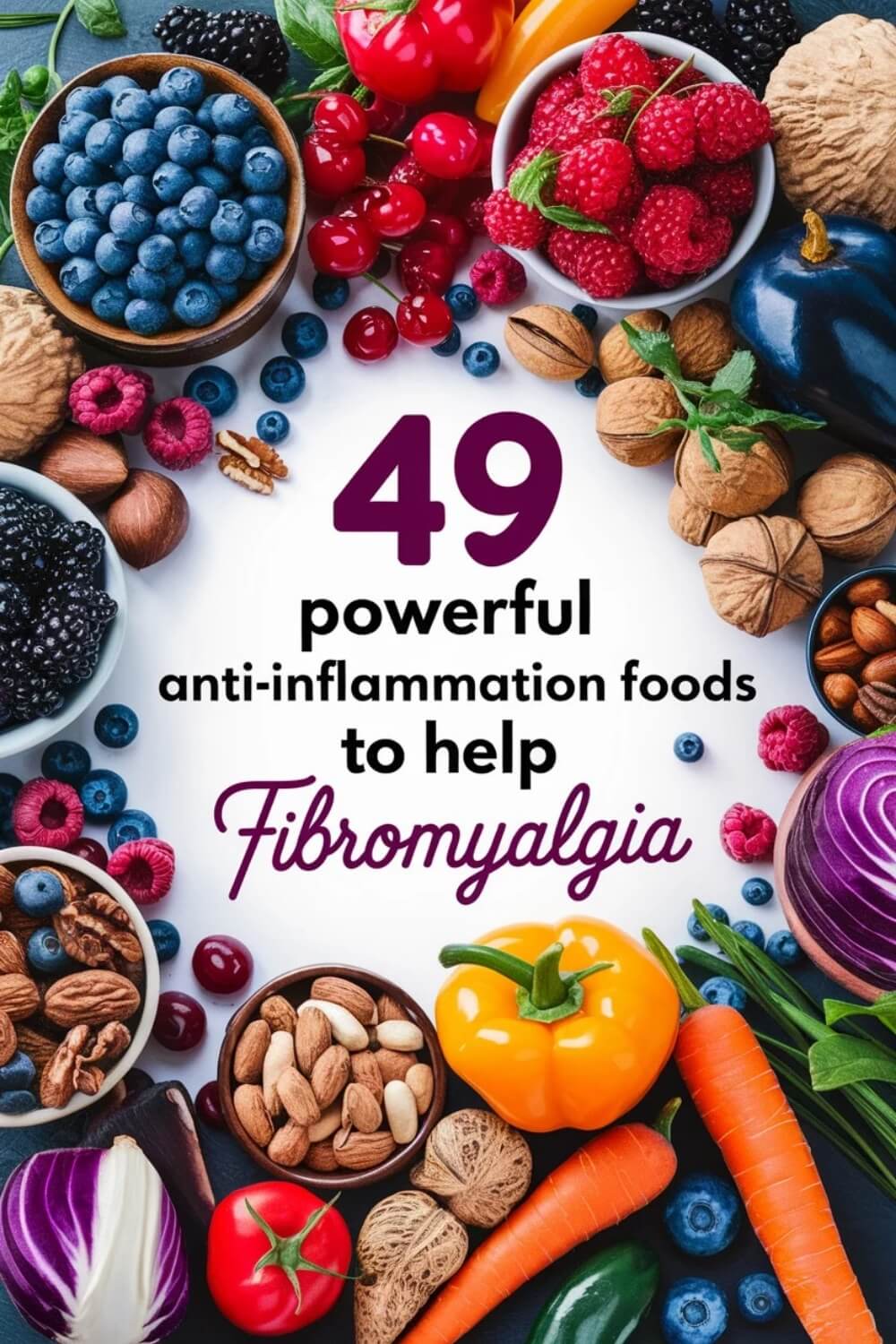49 Anti-Inflammation Foods to Manage Fibromyalgia
Have you ever felt as though your body was in constant battle, with every meal exacerbating your pain and discomfort? Anti-inflammation fibromyalgia foods might be the key to escaping this vicious cycle and finding relief from the pervasive symptoms of fibromyalgia.
Inflammation is a significant factor in fibromyalgia, intensifying pain, fatigue, and cognitive difficulties.
An anti-inflammatory diet prioritizes nutrient-rich, whole foods designed to minimize inflammation and enhance overall health. Research indicates that by avoiding inflammatory triggers and incorporating specific foods, individuals can alleviate symptoms and improve their quality of life.
Through mindful dietary changes, many individuals with fibromyalgia have achieved some relief, regaining control over their health.I have seen the transformative power of diet in action.
My wife, who has endured the challenges of stage IV endometriosis and fibromyalgia, struggled for years with how her diet affected her health. When she adopted a clean eating approach, the changes were profound—not just physically, but emotionally as well.
For those suffering from fibromyalgia, relief often begins at the dinner table. A diet abundant in anti-inflammatory foods can play a crucial role in symptom management and overall wellness.
Below, you’ll discover a comprehensive list of 49+ foods that can help you reduce inflammation and restore balance to your body.Let’s explore the benefits of anti-inflammation foods and learn how they can support your body in combating fibromyalgia.
- How Anti-Inflammation Foods Can Help Fibro?
- Ginger's Anti-Inflammatory Benefits
- Fatty Fish Rich in Omega-3s
- Berries Packed with Antioxidants
- Turmeric's Healing Properties
- Olive Oil's Heart-Healthy Qualities
- Chia Seeds for Omega-3 Boost
- Avocado's Healthy Fats
- Leafy Greens for Nutrient Density
- Broccoli's Detoxifying Properties
- Sweet Potatoes for Fiber and Vitamins
- Green Tea's Antioxidant Power
- Beets for Liver Health
- Quinoa as a Complete Protein
- Garlic's Immune-Boosting Effects
- Fermented Foods for Gut Health
- Mushrooms and Their Nutritional Benefits
- Coconut Oil's Healing Properties
- Pineapple's Digestive Properties
- Citrus Fruits for Vitamin C
- Pumpkin's Nutritional Value
- Nuts for Healthy Snacking
- Legumes as Fiber-Rich Foods
- Whole Grains for Energy
- Cinnamon's Anti-Inflammatory Effects
- Red Grapes and Their Antioxidants
- Dark Chocolate's Health Benefits
- Artichokes for Fiber and Antioxidants
- Cabbage's Nutritional Value
- Kefir for Probiotics
- Cauliflower's Versatility
- Apples as a Healthy Snack
- Fennel's Digestive Benefits
- Bell Peppers for Vitamin C
- Pomegranates and Their Nutrients
- Celery for Hydration
- Zucchini's Nutritional Benefits
- Honey's Natural Sweetener Qualities
- Turkey as Lean Protein
- Beef for Protein Source
- Eggs and Their Nutritional Value
- Sunflower Seeds for Snacking
- Flaxseeds for Omega-3s
- Green Peas for Fiber
- Raspberries for Antioxidants
- Cabbage for Nutritional Benefits
- Lentils for Plant-Based Protein
- Cilantro's Health Benefits
- Sardines for Omega-3 Oils
- Mint for Digestive Comfort
- Broccoli Sprouts for Nutritional Boost
- Best Anti-Inflammation Foods for Fibromyalgia
- How I Helped My Wife Heal with Anti-Inflammation Foods
- Final Word on Anti-Inflammation Foods for Fibromyalgia
How Anti-Inflammation Foods Can Help Fibro?
Fibromyalgia is more than just widespread pain—it’s a complex syndrome that influences energy levels, sleep, cognitive function, and overall quality of life. One of the primary factors exacerbating these symptoms is chronic inflammation, which affects the body’s pain receptors and contributes to the severe discomfort experienced by those with the condition. Addressing inflammation is crucial, and it goes beyond medication; it’s significantly influenced by daily dietary choices.
The foods you consume can either worsen fibromyalgia symptoms or help alleviate the internal turmoil. Anti-inflammation foods are rich in compounds that reduce oxidative stress, support hormonal balance, and enhance gut health—all essential for managing fibromyalgia.
My wife, suffering from what we now recognize as “fibro flares,” experienced episodes where she went from being active and energetic to being debilitated by pain and fatigue, a state often compounded by sleepless nights and mental fog. Initially, we struggled to identify the triggers. However, through research and trial, it became apparent that her diet played a pivotal role.
When she shifted her focus to nutrient-rich, anti-inflammatory foods, the transformation was palpable. The frequency of her painful episodes decreased, her energy levels stabilized, and her mental clarity improved. While not a cure, these dietary changes allowed her to regain some control over a body that often felt foreign and hostile.
Implementing an anti-inflammation diet involves more than segregating “good” from “bad” foods; it’s about embracing a lifestyle that prioritizes removing processed foods, added sugars, and inflammatory fats, while incorporating foods that combat inflammation, aid digestion, and foster recovery. This approach doesn’t just ease symptoms—it can fundamentally enhance the daily lives of those with fibromyalgia.
Ginger’s Anti-Inflammatory Benefits
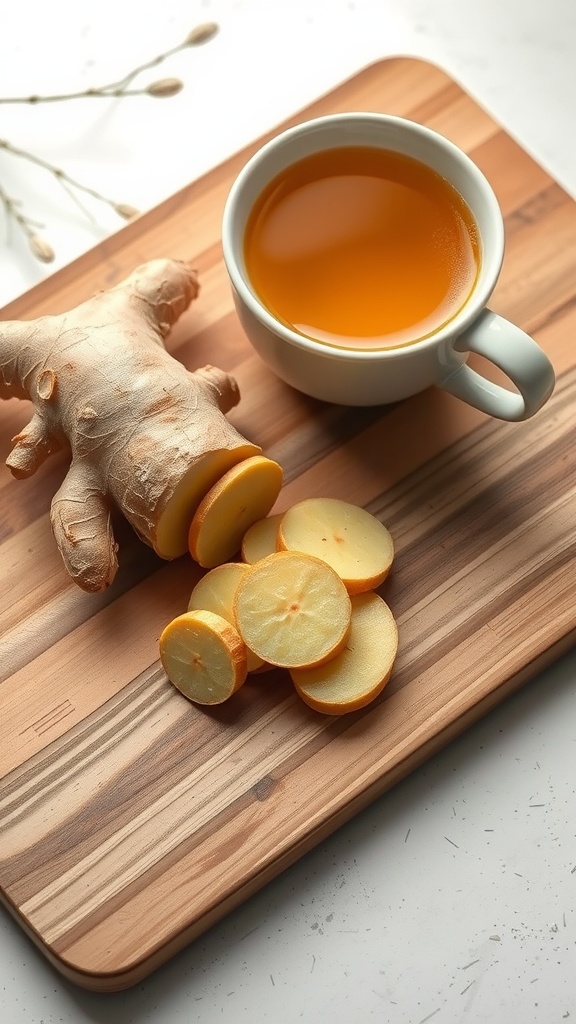
Ginger is a powerhouse when it comes to anti-inflammatory benefits. The image shows fresh ginger root alongside a cup of ginger tea, highlighting its versatility. This warming drink can be a great addition to your daily routine.
Ginger contains potent compounds like gingerol, which help reduce chronic inflammation. This is especially beneficial for those dealing with conditions like fibromyalgia. You can easily incorporate ginger into your diet by adding it to meals or enjoying it as tea.
If you’re looking for easy low FODMAP recipes, ginger fits right in. It’s considered an IBS-friendly food, making it perfect for low FODMAP meal prep. Try making ginger tea by steeping fresh ginger slices in hot water. It’s a simple way to enjoy an anti-inflammatory drink.
For a tasty and healthy lunch idea, consider a ginger-infused stir-fry. Use low FODMAP vegetables like carrots and zucchini, and add ginger for that extra kick. This can be a delicious anti inflammation meal that helps you feel your best.
Fatty Fish Rich in Omega-3s
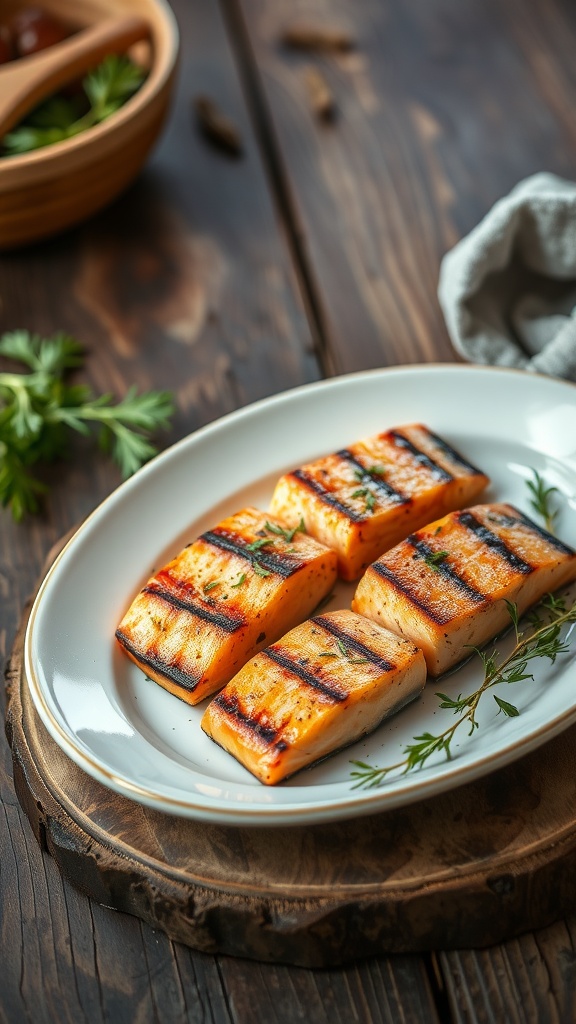
Fatty fish, like salmon and mackerel, are a fantastic addition to any low FODMAP meal plan. They are packed with omega-3 fatty acids, which are known for their anti-inflammatory properties. These nutrients can help reduce chronic inflammation in the body, making them a great choice for those managing fibromyalgia.
Incorporating these fish into your meals can be both delicious and beneficial. Think grilled salmon fillets served with a side of low FODMAP vegetables like spinach or zucchini. You can easily prepare an anti-inflammatory meal by seasoning the fish with herbs and a drizzle of olive oil, then grilling it to perfection.
For a quick bite, consider making anti inflammation snacks with smoked salmon on rice cakes topped with avocado. This combo not only tastes great but also fits well within an anti inflammation diet recipe. Enjoying fatty fish regularly can support overall health, making it a smart choice for anyone looking to reduce inflammation fast.
Remember, having a variety of antiinflammatory meals is key. Try experimenting with different fish and cooking methods to keep your meals exciting while sticking to a low FODMAP diet.
Berries Packed with Antioxidants
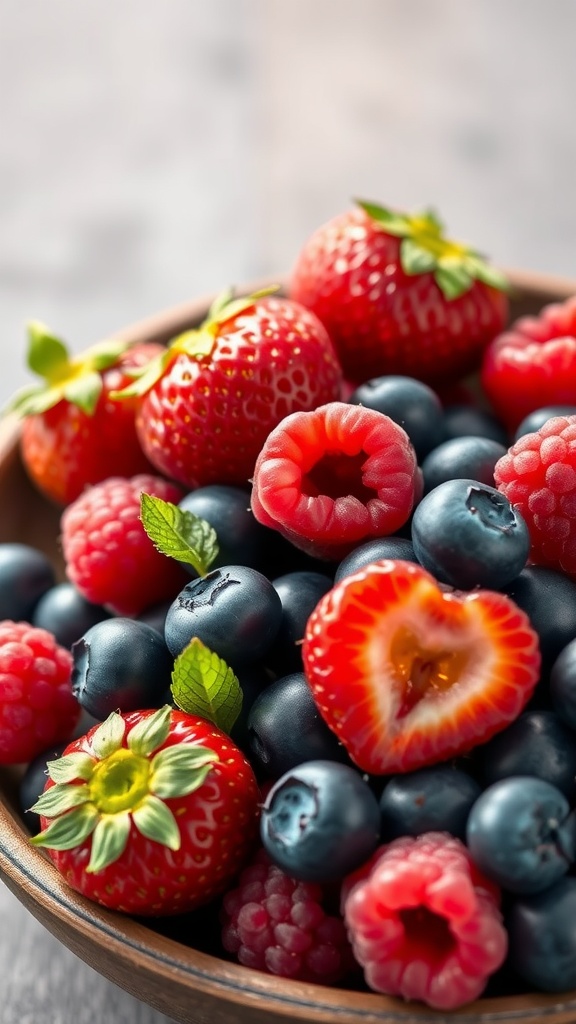
Berries are not just tasty; they are packed with antioxidants that can help reduce inflammation fast. These colorful fruits, like strawberries, blueberries, and raspberries, bring a burst of flavor along with their health benefits.
Including berries in your anti inflammation diet recipes can be easy and delicious. You can toss them into smoothies, salads, or even enjoy them as anti inflammation snacks. They are versatile and fit well into a variety of healthy lunch recipes.
For those following a low FODMAP diet, berries are an excellent choice. They are low in FODMAPs and can be part of your low FODMAP meal prep. Plus, they can add a sweet touch to your low FODMAP breakfast options.
So next time you’re thinking of what foods help with inflammation, remember to reach for that bowl of bright, delicious berries. They’re not only good for you, but they also make your meals pop with color and flavor!
Turmeric’s Healing Properties
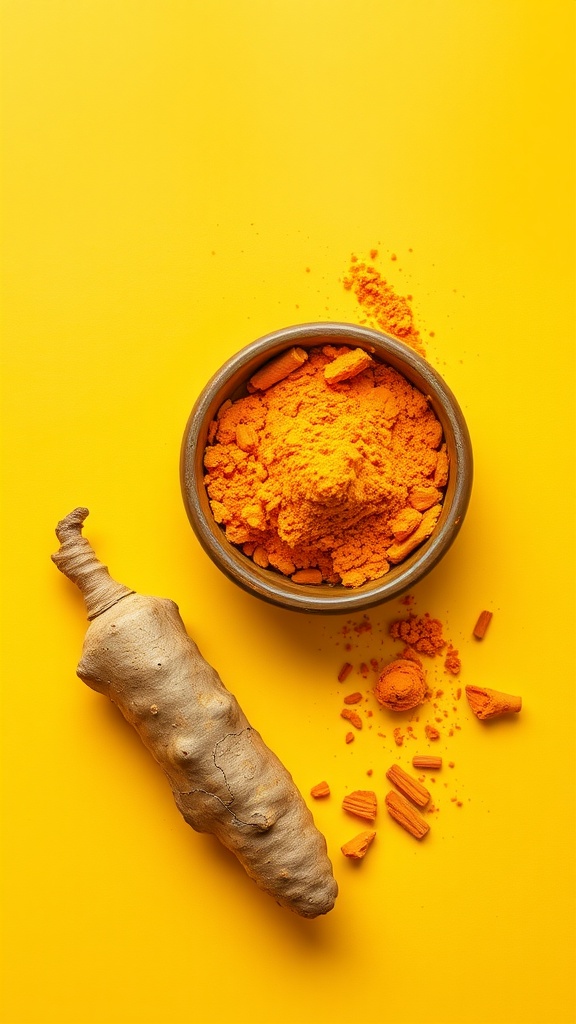
Turmeric is often called a superfood for good reason. The vibrant orange powder and the root itself are packed with curcumin, a compound known for its powerful anti-inflammatory effects. This makes turmeric a go-to ingredient for those looking to reduce inflammation fast.
Incorporating turmeric into your meals can be a tasty way to boost your anti-inflammation diet. Whether you’re making a curry or adding it to a smoothie, it’s easy to use. Many people on an IBS diet find it helpful too, as it fits nicely into low FODMAP meal prep.
For beginners, starting with easy low FODMAP recipes can include turmeric in salads or as a spice for roasted vegetables. This can help create anti-inflammatory meals that are both satisfying and nutritious. Don’t forget to pair it with black pepper to enhance curcumin absorption!
Looking for some quick ideas? How about an anti-inflammation breakfast with scrambled eggs and turmeric? Or a golden milk latte to sip on? Turmeric’s rich color not only adds a beautiful touch to your dishes but also offers numerous health benefits.
Make sure to explore various anti-inflammation recipes meals that incorporate non-inflammatory foods like ginger and leafy greens. This can really enhance your inflammation diet for beginners and support a healthier lifestyle overall.
Olive Oil’s Heart-Healthy Qualities
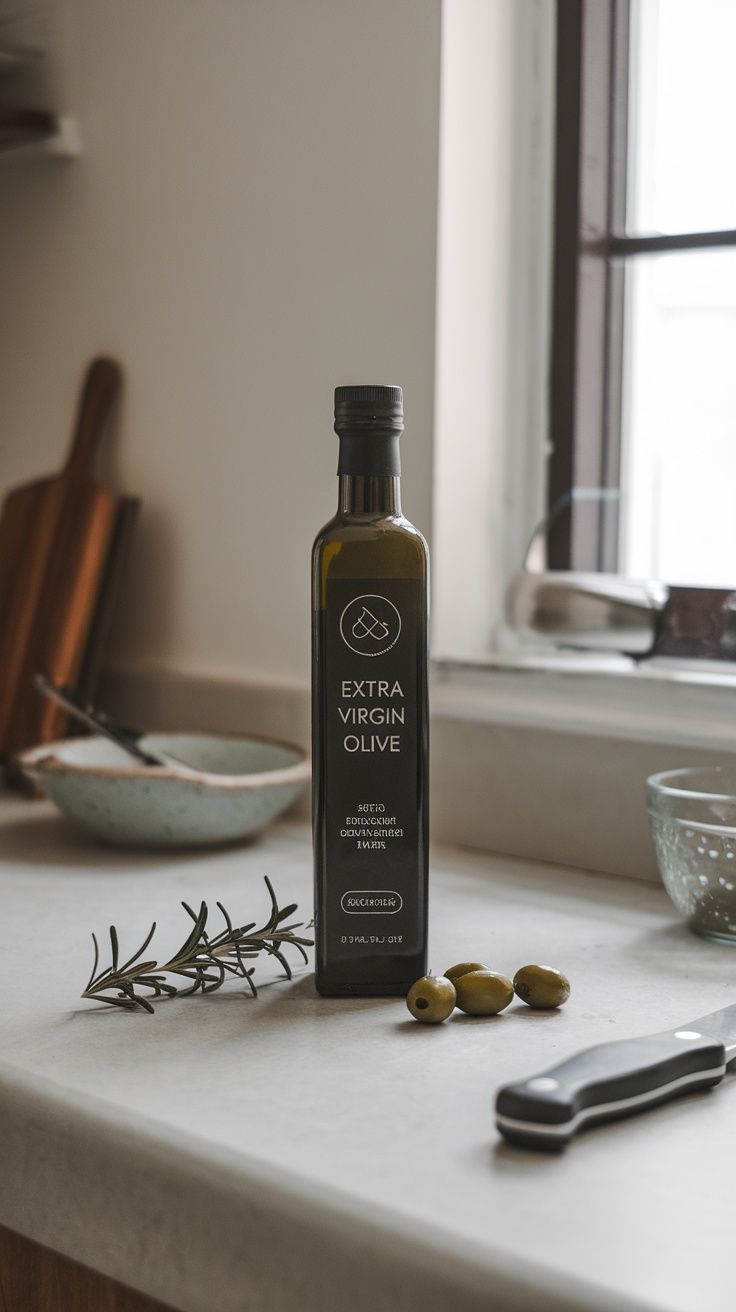
Olive oil is not just a staple in Mediterranean kitchens; it’s a true gem for those looking to manage inflammation. The image beautifully captures a bottle of extra virgin olive oil, showcasing its rich golden hue alongside fresh olives and herbs. This oil is packed with antioxidants and healthy fats, making it a great choice for an anti inflammation diet.
Using olive oil in your meals can enhance flavor while also providing health benefits. It’s one of those non inflammatory foods that fits perfectly into a healthy lunch or dinner. Drizzle it over salads, use it for sautéing low fodmap vegetables, or incorporate it into anti inflammation recipes meals.
When planning a low fodmap meal prep, olive oil is a versatile ingredient that can help reduce chronic inflammation. It pairs well with various foods, adding depth to your dishes without complicating your meal plan. You can even whip up easy low fodmap recipes featuring olive oil as a key ingredient.
For a quick anti inflammation breakfast, consider using olive oil in your cooking. Whether you’re making scrambled eggs or a simple veggie omelet, a splash of olive oil can elevate the taste while supporting your health goals. It’s a small change that can have a big impact on your overall well-being.
Chia Seeds for Omega-3 Boost
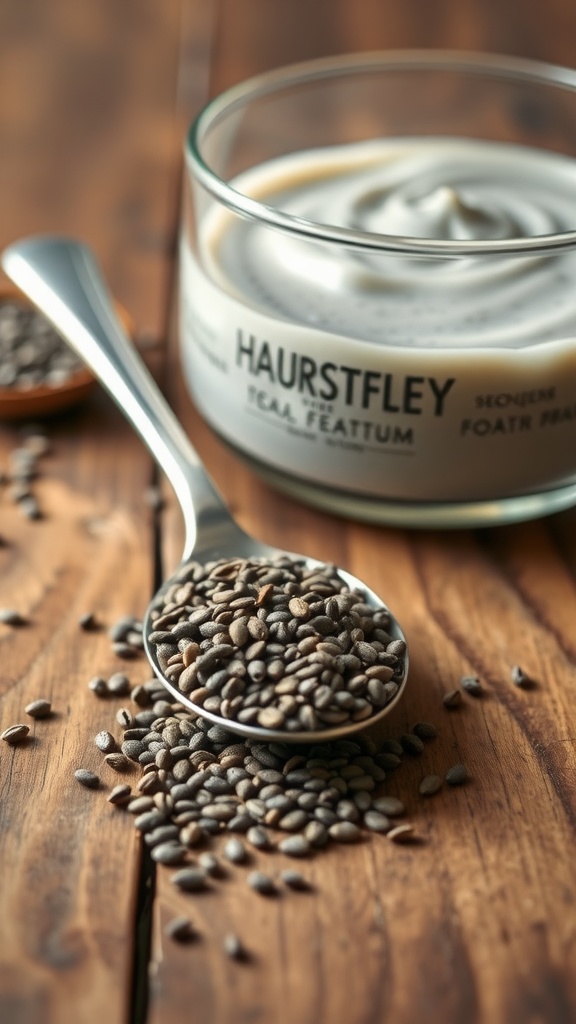
Chia seeds are small, but they pack a powerful punch when it comes to nutrition. These tiny seeds are an excellent source of omega-3 fatty acids, which are known for their anti-inflammatory properties. Adding chia seeds to your diet can help fight chronic inflammation, making them a great choice for anyone looking to manage fibromyalgia symptoms.
The image shows a spoonful of chia seeds resting on a wooden surface, with a bowl of creamy goodness nearby. This setup not only highlights the seeds but also suggests some delicious ways to incorporate them into meals. You can add them to smoothies, yogurt, or even sprinkle them over salads. They also make a fantastic base for easy low FODMAP recipes like chia pudding.
For those following a low FODMAP diet, chia seeds are a friendly option. They’re easy to incorporate into your low FODMAP meal plan and work well in anti inflammation recipes. You can combine them with low FODMAP fruits like bananas or strawberries for a tasty breakfast or snack. This makes chia seeds a versatile addition to your anti inflammation meal plan.
So, if you’re looking for non-inflammatory foods that can help with inflammation, don’t overlook these little powerhouses. They’re not just a trend; they’re a staple for anyone focused on clean eating and managing their health.
Avocado’s Healthy Fats
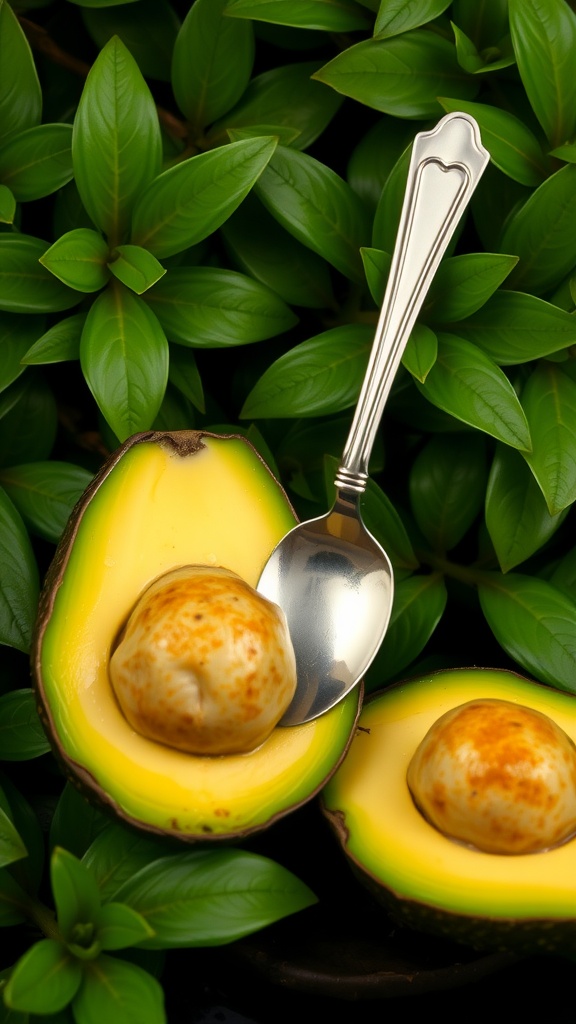
Avocado is a standout in the world of anti-inflammatory foods. This creamy fruit is packed with healthy fats, specifically monounsaturated fats. These are the good fats that can help reduce inflammation and support overall health.
In the image, we see a beautifully cut avocado with its vibrant green flesh and a shiny spoon ready to scoop up its goodness. The rich color of the avocado signifies its nutrient density, making it a great addition to clean eating and anti inflammation diet recipes.
Incorporating avocado into your meals can be simple. You can add slices to salads, mash it on whole-grain toast, or mix it into your favorite healthy lunch recipes. This versatility makes it a staple for anyone looking to reduce inflammation fast.
If you’re exploring low FODMAP lunch ideas, avocado can fit right in. Just remember to enjoy it in moderation, as it can be high in FODMAPs for some. Overall, it’s a delicious way to include non inflammatory foods in your diet.
Leafy Greens for Nutrient Density
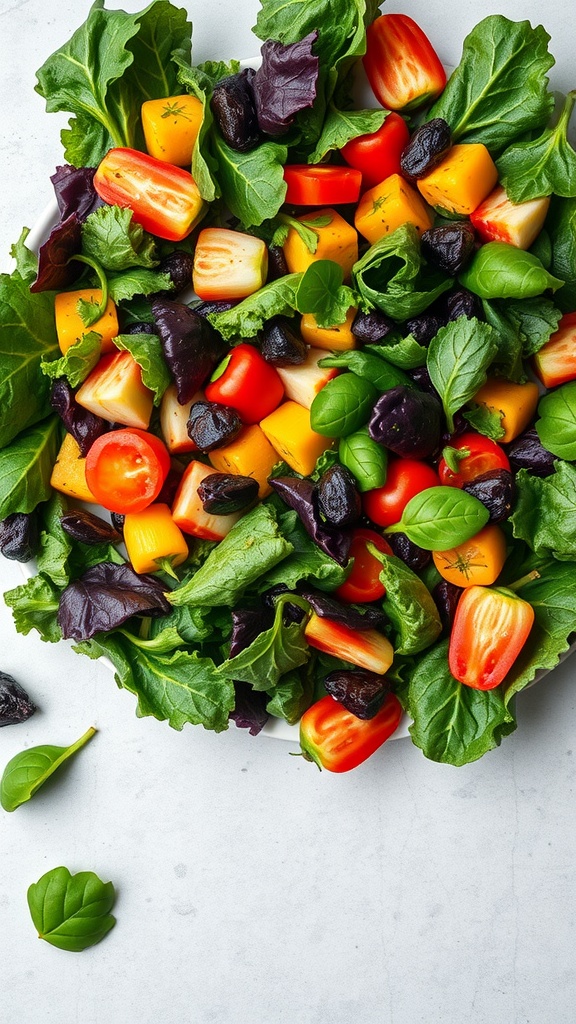
Leafy greens are among the best anti-inflammation foods you can include in your diet. They’re packed with vitamins, minerals, and antioxidants that help combat chronic inflammation. The vibrant salad in the image showcases a mix of greens, colorful veggies, and healthy toppings, making it a feast for both the eyes and the body.
Incorporating a variety of leafy greens like spinach, kale, and arugula can contribute to a low FODMAP meal prep. These greens are low in FODMAPs, making them suitable for anyone on a FODMAP diet for beginners. You can enjoy them in salads or smoothies, which are fantastic for reducing inflammation fast.
Salads are super easy to whip up. Just toss together your greens with some colorful veggies like bell peppers and tomatoes, as seen in the image. You can even add non-inflammatory foods like nuts or seeds for a crunchy texture. Drizzle with olive oil and lemon juice for a refreshing dressing. This simple recipe is a perfect example of clean eating.
For healthy lunch recipes, consider this leafy greens salad as a base. It’s not only delicious but also fits into an anti-inflammation meal plan. You can mix and match ingredients to create your own anti-inflammation snacks or meals. Whether you’re dealing with fibromyalgia, IBS, or just looking to eat better, this salad is a great choice!
So, embrace leafy greens and enjoy their nutrient density. They can play a vital role in your journey towards a healthier, inflammation-free life.
Broccoli’s Detoxifying Properties
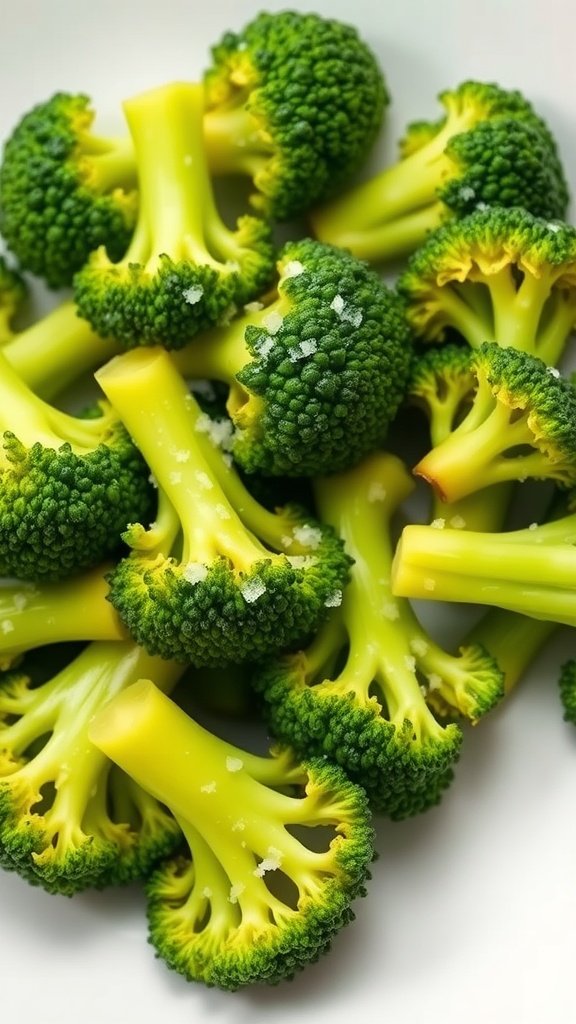
Broccoli is a powerhouse when it comes to detoxifying the body. This vibrant green vegetable is loaded with nutrients that help reduce chronic inflammation, making it perfect for those looking to improve their health.
Rich in antioxidants, broccoli fights free radicals and supports the body’s natural detox processes. It contains compounds called glucosinolates, which help the liver function better and eliminate toxins effectively.
Incorporating broccoli into your meals can be simple. You can steam it, toss it in salads, or add it to stir-fries. For an easy low FODMAP recipe, try roasting broccoli with a pinch of salt and a drizzle of olive oil. This makes a fantastic side dish or a healthy snack, aligning perfectly with an anti inflammation meal plan.
Not only does broccoli fit into a low FODMAP food list, but it also serves as an IBS-friendly food. When combined with other non-inflammatory foods, it can help create a balanced plate that supports overall wellness.
Sweet Potatoes for Fiber and Vitamins

Sweet potatoes are a fantastic choice for anyone looking to manage fibromyalgia symptoms. These vibrant tubers are packed with fiber, which is great for maintaining digestive health. High fiber foods can help reduce inflammation fast, making sweet potatoes a key player in an anti inflammation diet.
Not only do they offer fiber, but sweet potatoes are also rich in vitamins like A and C. These vitamins support your immune system and promote overall health. If you’re on a low FODMAP diet, sweet potatoes are a non inflammatory food that’s easy to incorporate into your meals.
For a simple side dish, try roasting sweet potatoes. Just cut them in half, season with olive oil, salt, and pepper, and bake until tender. This can be an easy low FODMAP recipe that pairs well with almost any main course.
They can also be mashed or used in soups for an anti inflammation meal plan. Plus, they make great anti inflammation snacks when sliced and baked into chips. So whether you’re looking for healthy lunch recipes or just a tasty addition to your plate, sweet potatoes have got you covered.
Green Tea’s Antioxidant Power
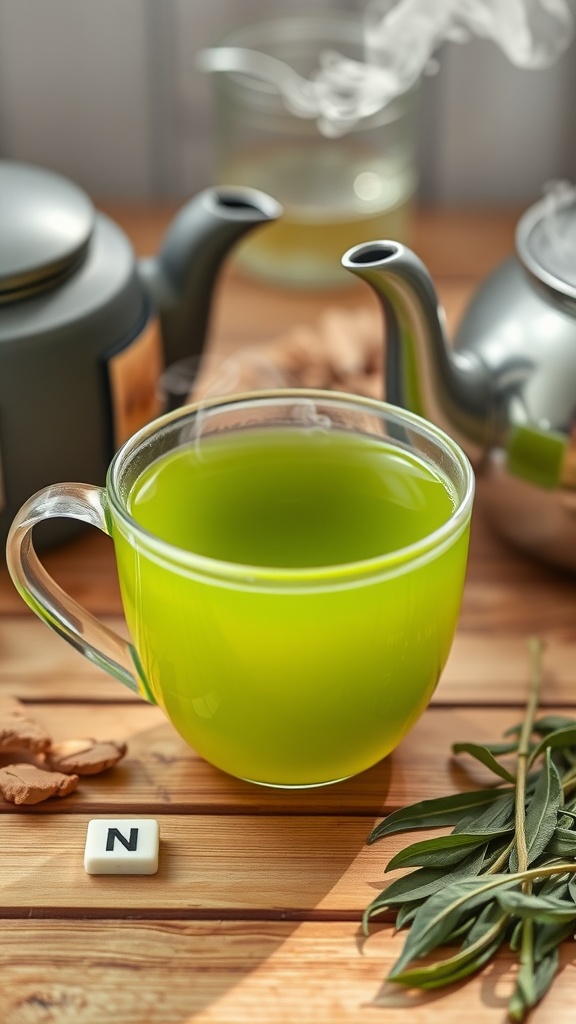
Green tea is a superstar in the world of anti-inflammatory foods. Its vibrant green color hints at the wealth of antioxidants it contains, especially catechins. These compounds help reduce inflammation and can be a great addition to an anti inflammation meal plan.
Imagine starting your day with a warm cup of green tea. Not only does it taste refreshing, but it also offers a gentle boost to your overall health. You can enjoy it as part of your low FODMAP breakfast, or sip it throughout the day as a calming anti inflammation snack.
For those following a low FODMAP diet, green tea is IBS-friendly and fits perfectly into your clean eating habits. You can pair it with antiinflammatory meals or even enjoy it alongside low FODMAP vegetables. Incorporating green tea into your routine can be a simple way to support your body in fighting chronic inflammation, making it a fantastic addition to your anti inflammation food list.
Beets for Liver Health
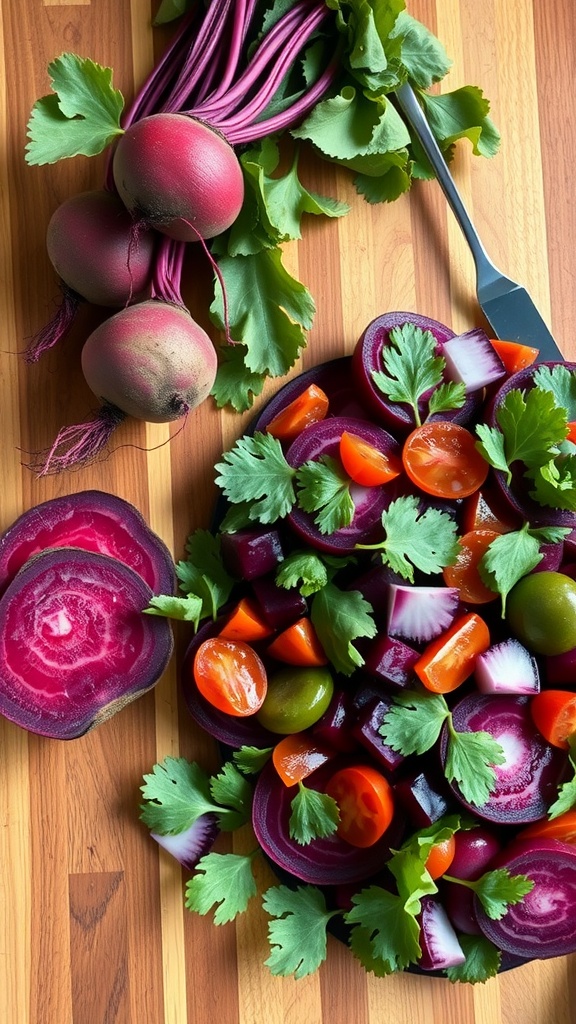
Beets are a fantastic addition to any anti-inflammation diet. They come packed with nutrients that can support liver health and help reduce inflammation in the body. This vibrant vegetable is known for its rich color and earthy flavor. In the image, you can see fresh beets alongside a colorful salad, showcasing how easy it is to incorporate them into meals.
Including beets in your diet can offer benefits like improved liver function and detoxification. They are low in calories and high in fiber, making them great for clean eating. You can easily add them to anti inflammation breakfast options or use them in anti inflammatory recipes meals. Try tossing them into a salad or blending them into a smoothie.
For those following a low FODMAP diet, beets are a friendly choice. You can enjoy them in low FODMAP snacks or as part of a low FODMAP meal plan. Keep things simple with easy low FODMAP recipes featuring roasted beets or a beet salad topped with fresh herbs and citrus.
Remember, foods that help with inflammation should be part of your regular meals. So why not make beets a staple in your healthy lunch recipes or anti inflammation meal prep? They are not just nutritious; they also add a beautiful pop of color to your dishes!
Quinoa as a Complete Protein
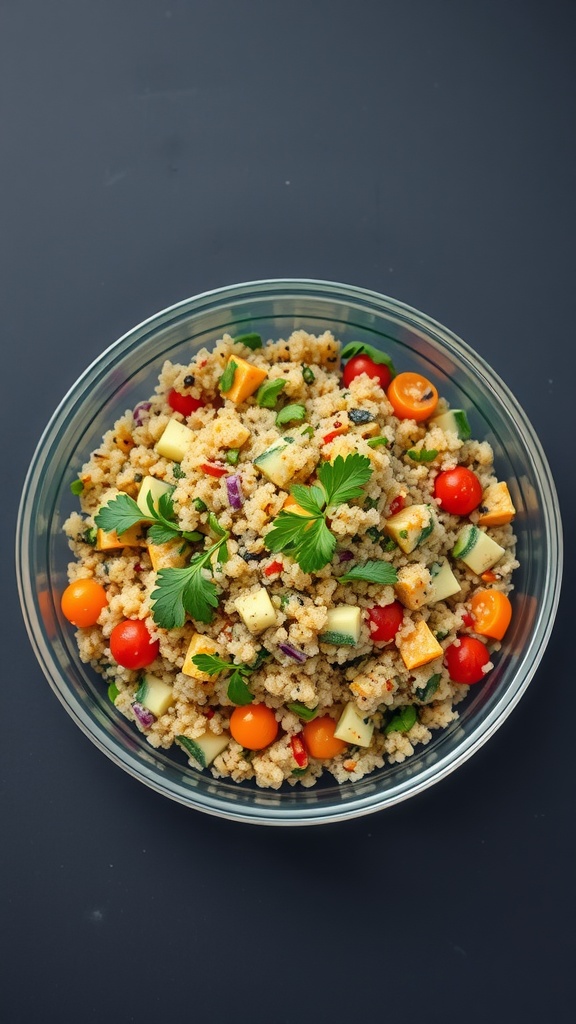
Quinoa is a fantastic food for anyone looking to manage fibromyalgia symptoms. It’s not just a trendy grain; it’s a complete protein. This means it contains all nine essential amino acids that your body needs but can’t produce on its own.
The image shows a vibrant quinoa salad packed with fresh vegetables like cherry tomatoes and cucumber. This colorful dish is not just pleasing to the eye but also packed with nutrients. Quinoa’s nutty flavor and versatile texture make it a great base for various anti-inflammation recipes meals.
For those exploring clean eating, quinoa fits perfectly into an anti inflammation meal plan. You can easily incorporate it into low FODMAP recipes breakfast or healthy lunch recipes. Mixing it with fresh veggies and a drizzle of olive oil makes for a quick, delicious dish that helps reduce inflammation fast.
If you’re starting with the FODMAP diet for beginners, quinoa is a friendly choice. It’s low in FODMAPs and is a staple in many IBS diet food lists. This makes it a great addition to your low FODMAP meal prep or low FODMAP meal plan. So, if you’re looking for non inflammatory foods, quinoa is a great pick!
Garlic’s Immune-Boosting Effects
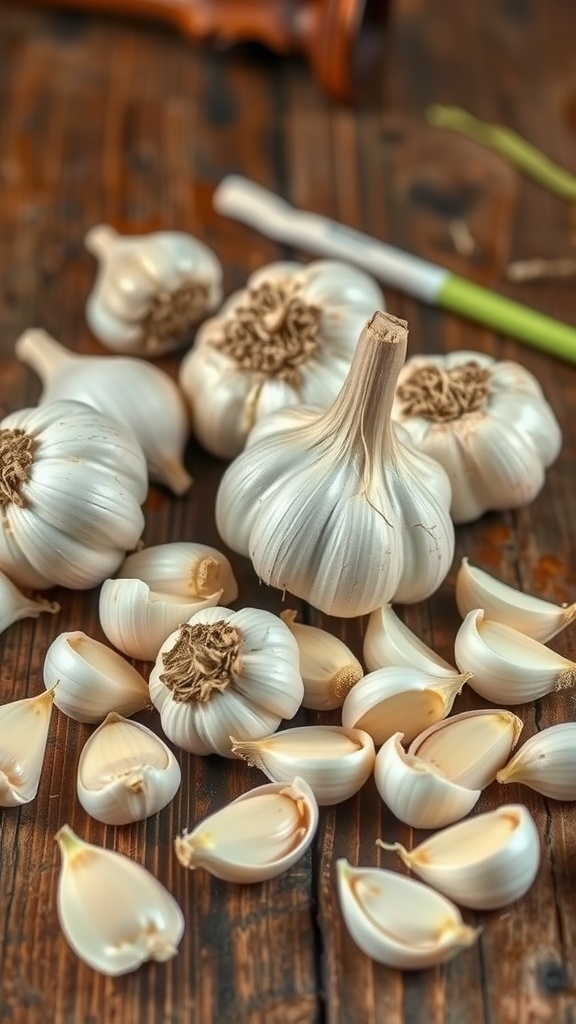
Garlic is more than just a flavor booster; it’s a powerhouse for your immune system. In the image, you see fresh garlic bulbs and cloves, ready to be added to your meals. Their unique taste enhances a variety of dishes while providing health benefits.
Garlic contains compounds like allicin, which are known for their ability to help reduce inflammation. Incorporating garlic into your meals can be a delicious part of an anti-inflammation meal plan. Try adding minced garlic to your low FODMAP lunch ideas or use it in healthy lunch recipes.
Whether you’re prepping anti inflammation snacks or looking for ingredients for anti inflammatory recipes meals, garlic should be high on your list. It’s a perfect fit for those following the FODMAP diet for beginners, as there are many ways to enjoy it without causing discomfort.
Consider mixing garlic into roasted low FODMAP vegetables for a tasty side dish. You can also use it to flavor your anti inflammatory foods, enhancing both taste and health benefits. This makes garlic an easy inclusion in your clean eating plan.
Fermented Foods for Gut Health
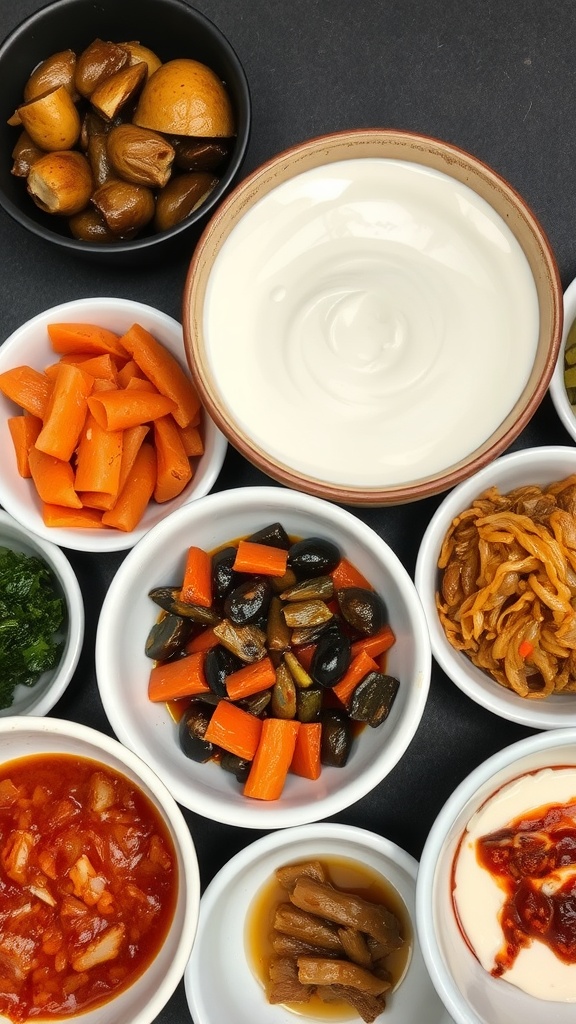
Fermented foods pack a punch when it comes to gut health. The image above shows a delightful spread of various fermented items. There’s creamy yogurt, vibrant pickled carrots, and savory olives. Each of these foods contributes to a healthy microbiome, which is crucial for reducing inflammation in the body.
Incorporating these foods into your meals can be simple. You might enjoy yogurt as part of an anti inflammation breakfast. Or consider mixing pickled vegetables into your salads for a tasty crunch. These options are not only delicious but also fit well within a low FODMAP diet, making them great choices for those with IBS.
For quick snacks, try some fermented veggies or a small serving of kimchi. These anti inflammation snacks can help keep your gut happy and your inflammation levels down. If you’re exploring low fodmap snacks, fermented foods can be a fantastic addition.
Remember, a balanced diet with a variety of anti inflammatory foods is key. So, feel free to mix and match these fermented goodies in your anti inflammation meal plan. They can easily be part of your low FODMAP meal prep, making healthy eating a breeze.
Mushrooms and Their Nutritional Benefits
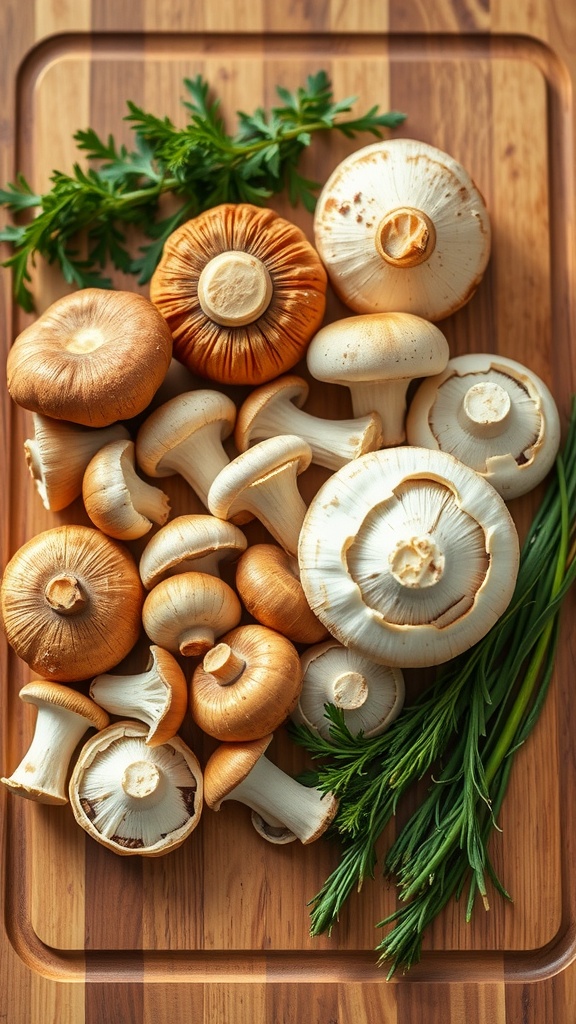
Mushrooms are more than just a delicious addition to meals; they pack a nutritional punch. They are low in calories and rich in essential nutrients, making them a great choice for anyone looking to follow an anti inflammation diet. With their unique flavors and textures, they can easily enhance various dishes.
These fungi are known for their anti-inflammatory properties. Certain types, like shiitake and maitake, contain compounds that can help reduce inflammation in the body. This is particularly beneficial for those dealing with chronic inflammation or conditions like fibromyalgia.
Incorporating mushrooms into your meals is easy. Whether in an antiinflammatory breakfast, a hearty salad, or as a side dish, they fit right in. You can use them in various antiinflammatory meals, making them a versatile ingredient in your diet. For those following a low FODMAP diet, mushrooms also provide a good option, as they are considered low FODMAP when consumed in moderation.
Try sautéing mushrooms with some garlic and olive oil for a simple, tasty side dish. This easy low FODMAP recipe is quick to prepare and packed with flavor. Pair it with some grilled chicken or add it to your favorite anti inflammation meal plan. Embracing mushrooms in your diet is a delicious way to support your health!
Coconut Oil’s Healing Properties

Coconut oil is more than just a trendy ingredient; it’s packed with healing properties that can benefit those dealing with chronic inflammation. The image shows a jar of coconut oil surrounded by fresh coconuts, set against a backdrop of palm trees and a serene sky. This visual speaks to the natural origins of coconut oil and its health benefits.
This oil is known for its anti-inflammatory properties, making it a key player in any anti inflammation diet. It can be easily added to various meals, enhancing flavors while promoting wellness. Think about incorporating it into your cooking, whether you’re making anti inflammation meals or whipping up easy low fodmap recipes.
Using coconut oil is simple. Drizzle it over vegetables or use it in healthy lunch recipes. You can even create anti inflammation snacks by combining it with nuts or seeds. It’s also a great base for low fodmap meal prep, ensuring you have delicious, inflammation-fighting foods ready to go.
So, if you’re looking to reduce inflammation fast, don’t overlook this versatile oil. Whether you’re enjoying it in your morning coffee or as part of an anti inflammation breakfast, coconut oil can be a delicious way to support your health.
Pineapple’s Digestive Properties
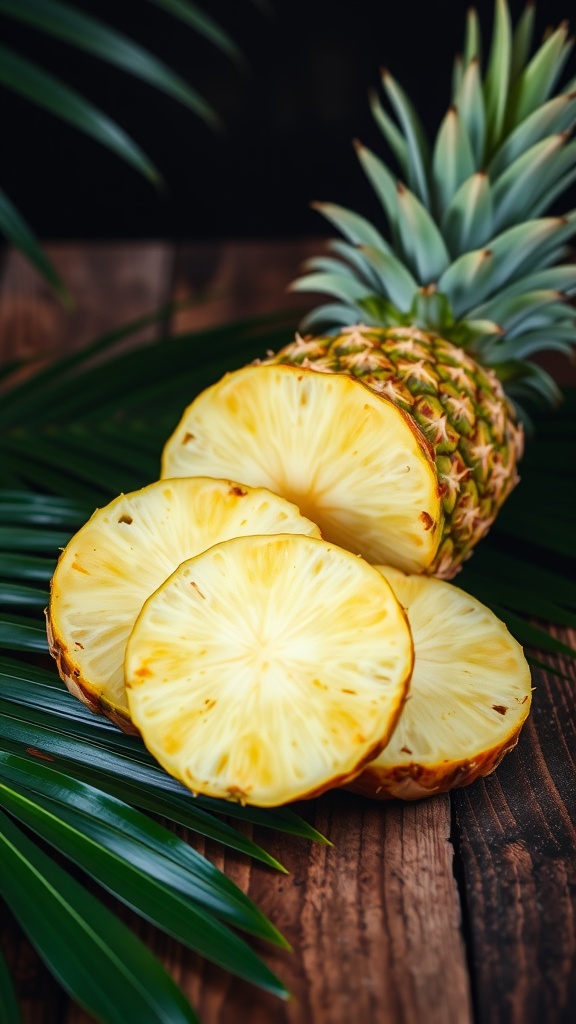
Pineapple is not just a tropical delight; it’s packed with benefits, especially for digestion. The image shows a vibrant pineapple, sliced to reveal its juicy, golden flesh. This fruit is not only visually appealing but also offers a wealth of health advantages.
Pineapples are rich in bromelain, an enzyme that helps break down protein. This can be very helpful for those on a low FODMAP diet, as it aids digestion and may reduce bloating. Including pineapple in your meals can complement anti-inflammatory foods, making it a fantastic addition to an antiinflammatory food list.
For an easy low FODMAP recipe, try a pineapple salsa. Just mix fresh pineapple chunks, chopped cilantro, lime juice, and a pinch of salt. It makes a refreshing topping for grilled fish or chicken, aligning perfectly with an anti inflammation meal plan. Plus, it’s a great anti inflammation snack!
Incorporating pineapple into your anti inflammation breakfast can be simple too. Add it to smoothies or use it in low FODMAP meal prep to keep digestive issues at bay while enjoying delicious flavors. The fruits are also great in low FODMAP lunch ideas, providing energy without the discomfort that comes from chronic inflammation.
Citrus Fruits for Vitamin C
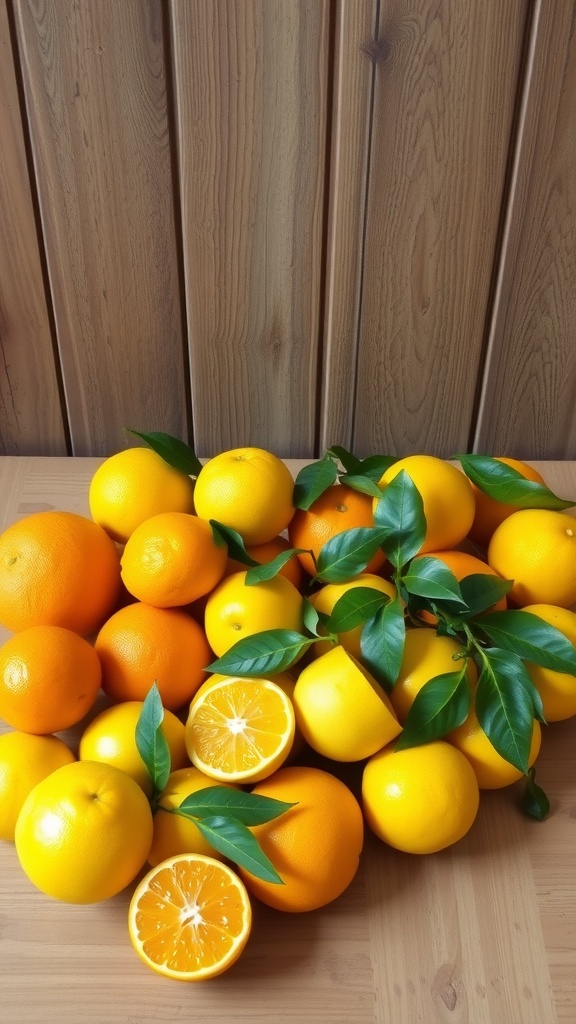
Citrus fruits, like oranges, are packed with vitamin C, which is crucial for those looking to manage fibromyalgia symptoms. These vibrant fruits not only brighten up your plate but also offer powerful anti-inflammatory benefits.
The image shows a delightful assortment of oranges, all fresh and full of life. Their bright color and texture make them appealing, encouraging you to reach for them when planning your meals. Including these fruits in your diet can be an easy way to boost your intake of non-inflammatory foods.
Vitamin C plays a significant role in reducing chronic inflammation, making citrus fruits an excellent addition to your anti inflammation meal plan. They can easily be incorporated into various antiinflammatory meals or snacks. Try adding orange slices to your salads or smoothies for a refreshing twist.
For those following a low FODMAP diet, oranges are safe and can be enjoyed as part of your healthy lunch recipes or even as a simple, tasty anti inflammation breakfast. They not only help reduce inflammation fast but also satisfy your sweet tooth without the guilt.
Next time you’re at the store, don’t forget to grab some citrus fruits. They’re not just delicious; they’re also a smart choice for anyone aiming to manage inflammation and enjoy clean eating.
Pumpkin’s Nutritional Value

Pumpkins are not just for decoration; they pack a nutritional punch! This vibrant squash is rich in vitamins and minerals essential for health. Pumpkins are loaded with vitamin A, which is great for eyesight and skin health. They also provide a good amount of vitamin C, helping to support the immune system.
Additionally, pumpkins are low in calories and high in fiber, making them a perfect fit for a low FODMAP diet. This fiber helps with digestion, which is beneficial for those dealing with IBS. Incorporating pumpkin into your meals can help reduce inflammation fast, making it an excellent choice for an anti inflammation diet.
The seeds, too, shouldn’t be overlooked. Pumpkin seeds are full of healthy fats, magnesium, and zinc, providing a boost to your overall nutrition. You can simply roast them for a crunchy snack or add them to salads. They fit perfectly in low fodmap meal prep, providing both flavor and health benefits.
Try adding pumpkin to your anti inflammation recipes meals. It can be blended into smoothies, soups, or even baked goods. Whether you’re enjoying an anti inflammation breakfast or a healthy lunch, pumpkin is a versatile ingredient that can help with inflammation.
Nuts for Healthy Snacking
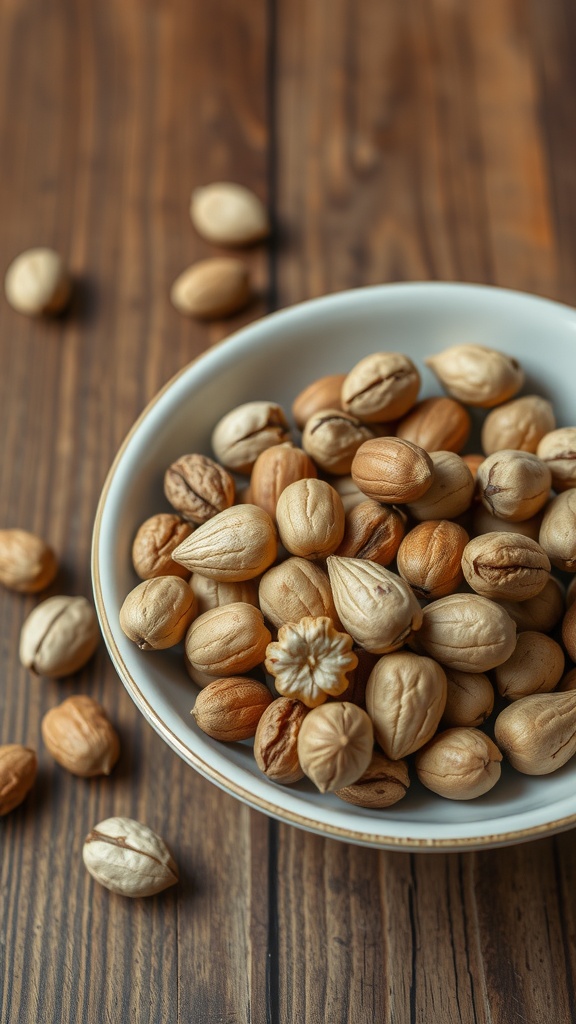
Nuts are a fantastic addition to your diet, especially when looking for non inflammatory foods. They pack a punch of nutrients while being easy to snack on. The image shows a variety of nuts, some still in their shells, showcasing their natural beauty. These little powerhouses can contribute to an anti inflammation meal plan.
Including nuts in your daily routine can help reduce inflammation fast. They are not just delicious, but also full of healthy fats, proteins, and vitamins. Whether you’re munching on them raw or adding them to anti inflammatory recipes meals, they can elevate your snack game.
If you’re following a low FODMAP diet, many nuts are actually IBS friendly food. Almonds, walnuts, and pecans can be great options. Just remember to pay attention to portion sizes, as they can be high in FODMAPs when consumed in large amounts. Pairing nuts with low fodmap snacks like fruits or veggies can create a balanced treat.
Feeling hungry between meals? Grab a handful of nuts for a quick pick-me-up. They fit perfectly into any healthy lunch recipes or can be part of easy low FODMAP recipes for breakfast. So next time you’re in need of a snack, reach for some nuts and enjoy their benefits!
Legumes as Fiber-Rich Foods
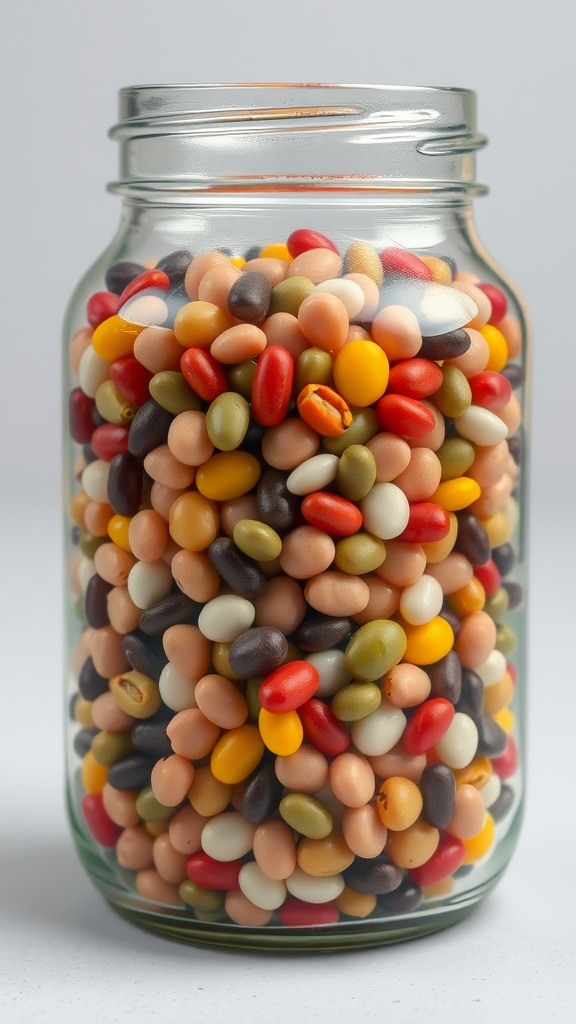
Legumes are a fantastic addition to any anti inflammation meal plan. They are packed with fiber and protein, making them ideal for those looking to reduce inflammation fast. The image shows a beautiful jar filled with colorful beans, highlighting the variety that legumes offer.
Incorporating legumes into your diet can be simple and enjoyable. From black beans to lentils, these foods are often featured on low FODMAP food lists, making them suitable for those following a low FODMAP diet. This is particularly beneficial for people with IBS.
Legumes serve as non inflammatory foods that can help manage chronic inflammation. You can enjoy them in salads, soups, or even as a side dish. Easy low FODMAP recipes, like a lentil salad or bean chili, can be made with just a few ingredients.
If you’re preparing low FODMAP meal prep, planning meals around legumes can be a game changer. They not only add flavor but also provide a hearty texture to your dishes. Consider making an anti inflammation breakfast by adding beans to your morning wraps or smashing them into your avocado toast.
For healthy lunch recipes, try using chickpeas in a salad or mixing black beans into quinoa. The options are endless, and legumes are also a great source of low FODMAP snacks. So next time you’re at the grocery store, fill your cart with these colorful gems!
Whole Grains for Energy
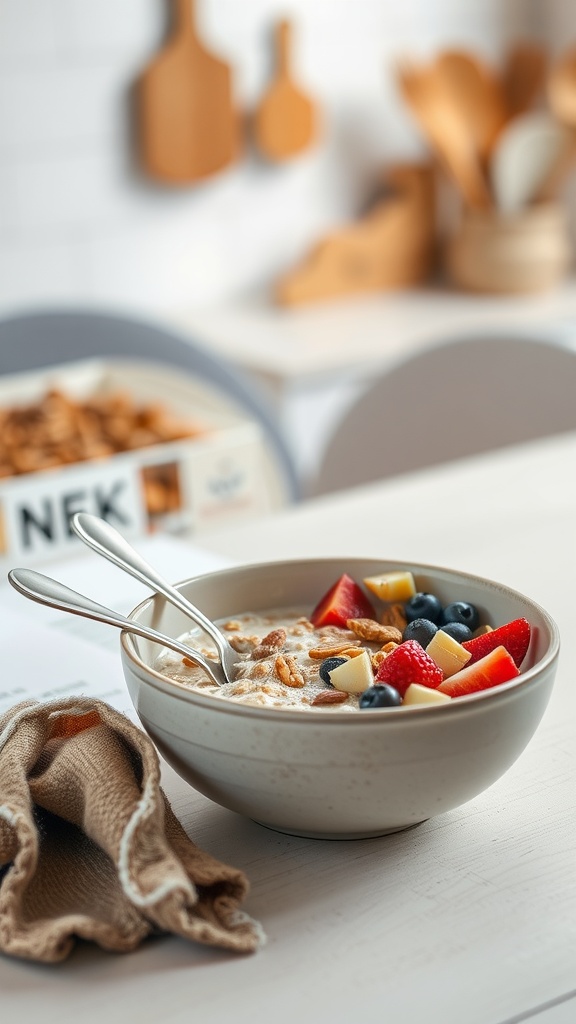
Whole grains are fantastic for keeping your energy levels up, especially for those dealing with fibromyalgia. The image shows a delicious bowl of oatmeal topped with fresh fruits like blueberries and strawberries. This breakfast not only looks appealing but is also packed with nutrients.
Whole grains like oatmeal, quinoa, and brown rice are great anti-inflammation foods. They help reduce chronic inflammation and can be easily incorporated into an anti-inflammation meal plan. Starting your day with an anti inflammation breakfast like oatmeal can set a positive tone for the rest of your meals.
For a quick and easy low FODMAP recipe, try making oatmeal with almond milk and topping it with your favorite fruits. You can also mix in some nuts or seeds for added texture and nutrients. These foods are IBS-friendly and can fit well into a low FODMAP diet.
Overall, including whole grains in your daily meals can help manage inflammation, boost energy, and support a healthy lifestyle.
Cinnamon’s Anti-Inflammatory Effects

Cinnamon is not just a tasty spice; it’s also a powerful ally against inflammation. The image showcases cinnamon sticks and ground cinnamon, which are rich in antioxidants. These antioxidants play a key role in fighting chronic inflammation, making cinnamon a great addition to an anti-inflammation diet.
Incorporating cinnamon into your meals can be easy. You can sprinkle it on oatmeal or mix it into smoothies for an anti inflammation breakfast. For those following a low FODMAP diet, cinnamon is IBS friendly and can be used in various low FODMAP meal prep recipes.
Whether you’re looking for anti inflammation snacks or trying to whip up easy low FODMAP recipes, cinnamon can enhance the flavor while helping to reduce inflammation fast. It pairs well with many non inflammatory foods, making it a versatile spice for healthy lunch recipes and anti inflammation meal plans.
If you’re interested in an anti inflammation diet for beginners, consider adding cinnamon to your anti inflammatory food list. It’s an easy way to boost your meals with health benefits!
Red Grapes and Their Antioxidants
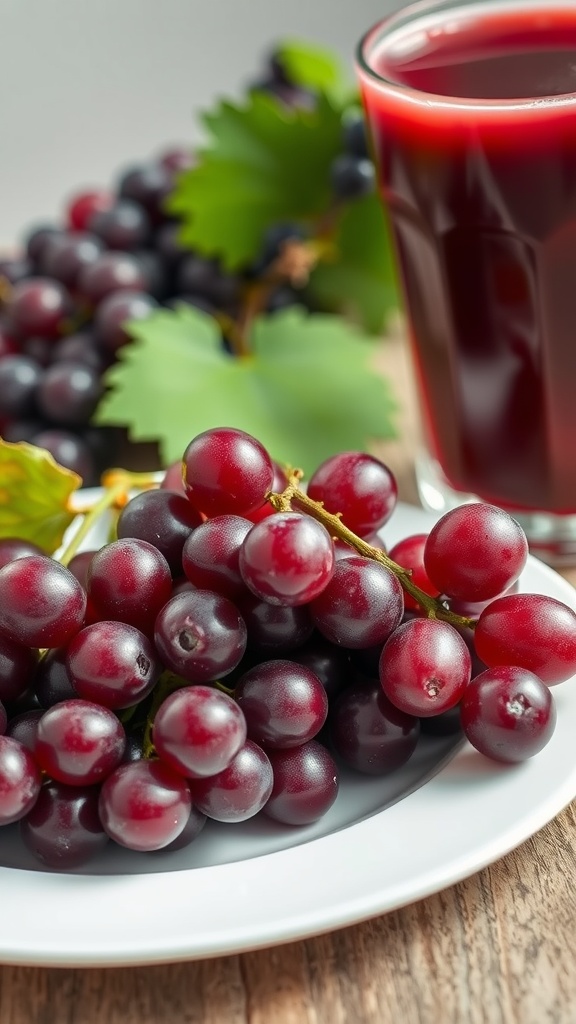
Red grapes are not just a tasty snack; they are packed with antioxidants that can help in fighting inflammation. The vibrant color of these grapes indicates the presence of powerful compounds like resveratrol. These compounds play a role in reducing inflammation, making them a great addition to anti-inflammatory meals.
Whether you enjoy them fresh or as a juice, red grapes fit well into a clean eating plan. You can easily incorporate them into your diet. Toss them into a salad, blend them into a smoothie, or simply enjoy them as a low FODMAP snack.
Incorporating red grapes into your anti inflammation meal plan can also be as simple as adding them to your breakfast. Try mixing them into yogurt or oatmeal for a delicious start to your day. They are versatile and can be used in various easy low FODMAP recipes that are sure to please your palate.
Dark Chocolate’s Health Benefits

Dark chocolate isn’t just a treat; it’s packed with benefits that are great for those dealing with fibromyalgia. In the image, you see a rich bar of dark chocolate surrounded by coffee beans and nuts. This combination highlights how chocolate can pair well with other delicious foods.
One of the standout features of dark chocolate is its ability to reduce inflammation. The cocoa in dark chocolate contains antioxidants that combat oxidative stress and help lower inflammation markers in the body. This makes it an excellent addition to an anti inflammation meal plan.
If you’re looking for easy ways to include dark chocolate in your diet, consider adding it to your breakfast. You can melt some over oatmeal or even mix it into a smoothie. It’s also a great low fodmap snack option when paired with nuts or seeds.
For those on a low fodmap diet, choosing dark chocolate with a high cocoa percentage (70% or more) is key. This ensures you get the health benefits without triggering IBS symptoms. So, whether you enjoy it on its own or as part of anti inflammation recipes meals, dark chocolate can be a tasty and healthy choice.
Artichokes for Fiber and Antioxidants
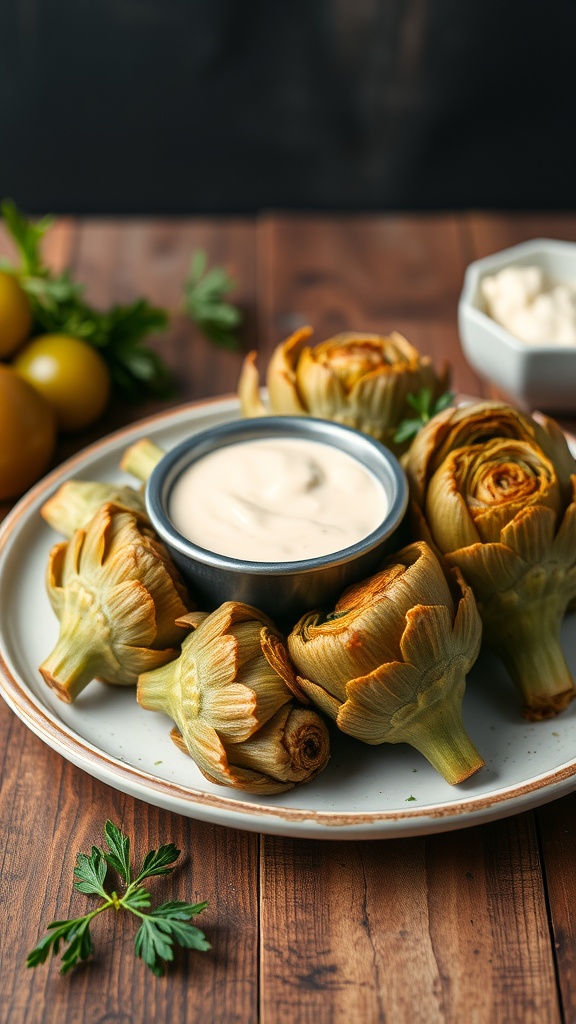
Artichokes are a fantastic addition to your plate, especially if you’re looking into anti-inflammation foods. These unique vegetables are packed with fiber and antioxidants, making them a great choice for anyone managing chronic inflammation.
The image showcases beautifully prepared artichokes, served with a creamy dip. This presentation not only makes for a healthy lunch option but also fits into low FODMAP diets. The combination of artichokes with a delicious dipping sauce can make your meals feel indulgent without compromising on health.
When you consume artichokes, you are not just enjoying their delightful taste, but also benefiting from their high fiber content. This can be particularly helpful for those following IBS diet food lists, as fiber is essential for digestive health. Plus, incorporating these into your anti inflammation meal plan can help reduce inflammation fast and support your journey towards clean eating.
Cabbage’s Nutritional Value
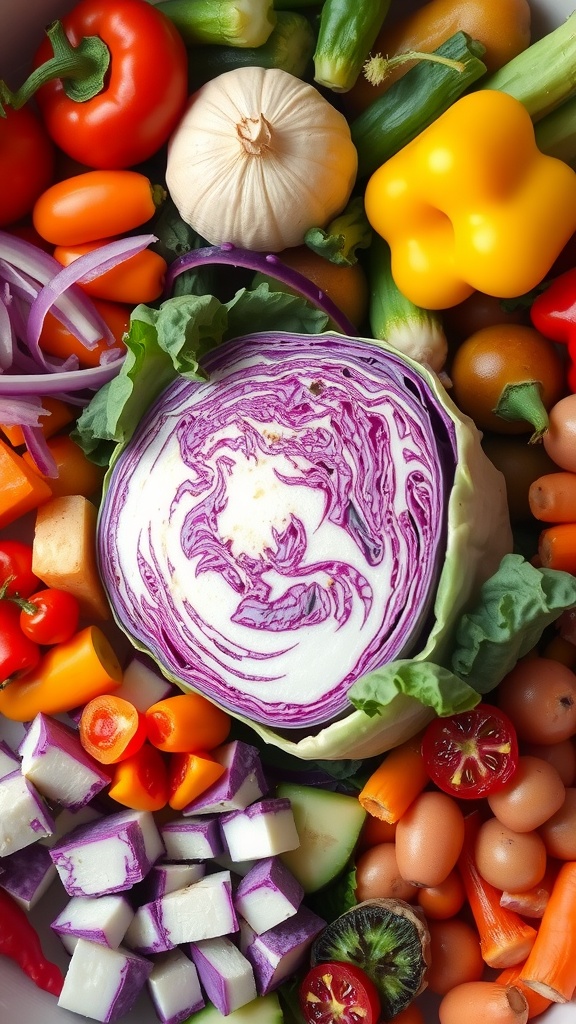
Cabbage is a fantastic addition to any anti-inflammation meal plan. It’s packed with vitamins C and K, which are essential for boosting your immune system and reducing inflammation. The crunchy texture and mild flavor make it perfect for salads, stir-fries, or even as a low FODMAP snack.
Incorporating cabbage into your diet can provide a solid source of fiber, which benefits gut health. This is especially helpful if you’re following an IBS diet food list. Fiber helps in maintaining a healthy digestive system, which is crucial for those dealing with chronic inflammation.
When considering foods for inflammation, cabbage is a top choice. You can enjoy it raw, steamed, or fermented as sauerkraut, which also adds probiotics for gut health. It’s a versatile ingredient that fits well into low FODMAP easy meals, making it an excellent choice for those new to the FODMAP diet.
For an easy low FODMAP recipe, try adding shredded cabbage to a salad with carrots and bell peppers. Dress it with olive oil and lemon juice for a refreshing anti inflammation breakfast or lunch. So, if you’re looking for non-inflammatory foods, cabbage should definitely be on your list!
Kefir for Probiotics

Kefir is a delightful fermented drink that packs a punch when it comes to probiotics. It’s creamy and can be enjoyed on its own or added to smoothies and cereals. The image shows a glass of kefir, garnished with fresh herbs, which highlights its refreshing quality.
This drink is a great addition to an anti-inflammation diet. Probiotics in kefir can aid digestion and help reduce chronic inflammation in the body. For those following a low FODMAP diet, kefir made from lactose-free milk can be a fantastic option, offering a tasty way to support gut health.
Consider including kefir in your meal prep for easy low FODMAP snacks or breakfasts. You can blend it with fruits for a quick smoothie or pair it with gluten-free granola. It’s a versatile ingredient that fits well into anti-inflammatory meal plans, making it easier to stick to non-inflammatory foods.
If you’re looking for anti-inflammation recipes, try making a kefir salad dressing or using it in baked goods. The options are endless, and you can enjoy the benefits while keeping your meals exciting!
Cauliflower’s Versatility
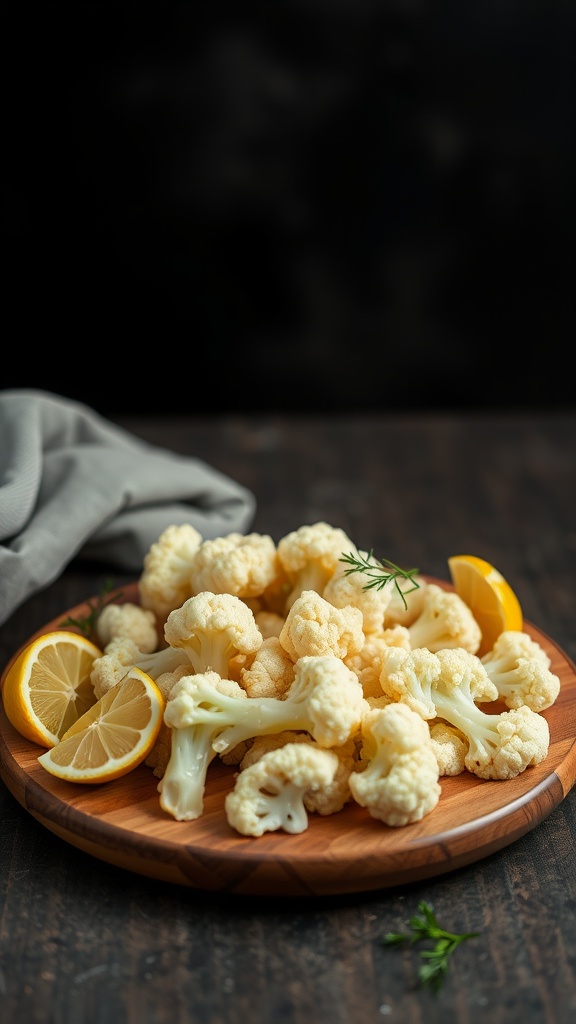
Cauliflower is a superstar in the kitchen, especially for those focused on anti-inflammation diets. This humble vegetable can be transformed into so many dishes, making it a fantastic addition to your meals.
In the image, we see fresh cauliflower florets arranged beautifully on a wooden platter. The bright yellow lemon slices next to them add a refreshing touch. This not only enhances the dish’s appearance but also hints at the flavor possibilities. Lemon pairs wonderfully with cauliflower, bringing a zest that can brighten up any anti-inflammatory meal.
With its low-carb nature, cauliflower fits perfectly into a low FODMAP meal prep plan. Whether you’re whipping up easy low FODMAP recipes like cauliflower rice or creamy cauliflower soup, this veggie is always a hit. It’s also a great base for healthy lunch recipes or snacks, ideal for anyone looking to reduce inflammation fast.
By incorporating cauliflower into your anti inflammation meal plan, you can enjoy a variety of dishes. Think roasted cauliflower with spices, cauliflower mash as a substitute for traditional mashed potatoes, or even cauliflower pizza crust. The options are endless!
So, the next time you’re looking for anti-inflammatory foods, remember to grab some cauliflower. It’s not just a side dish; it’s a versatile ingredient that can be the star of your meals.
Apples as a Healthy Snack

Apples are more than just a tasty treat; they play a big role in clean eating and can be a great choice for anyone looking to reduce inflammation. This colorful basket of apples showcases their natural beauty and diversity. With their crisp texture and refreshing flavor, apples are not only satisfying but also packed with nutrients.
These fruits are a staple on the anti-inflammatory food list. They contain antioxidants that can help combat chronic inflammation. Whether you prefer them as part of an anti inflammation meal plan or just as a quick snack, apples fit perfectly into a low FODMAP diet. They’re easy to grab when you need something healthy on the go.
For those following an inflammation diet for beginners, apples can be a wonderful addition. You can slice them for an anti inflammation breakfast or toss them into a salad for a healthy lunch. Their versatility makes them ideal for antiinflammatory meals. Plus, they can be enjoyed alone or integrated into anti inflammation recipes meals.
Next time you’re in need of low FODMAP snacks or easy low FODMAP recipes, remember that apples offer a delicious solution. Keep them in mind as you plan your meals, whether it’s low FODMAP lunch ideas or even low FODMAP meal prep for the week. Snack smart with apples!
Fennel’s Digestive Benefits
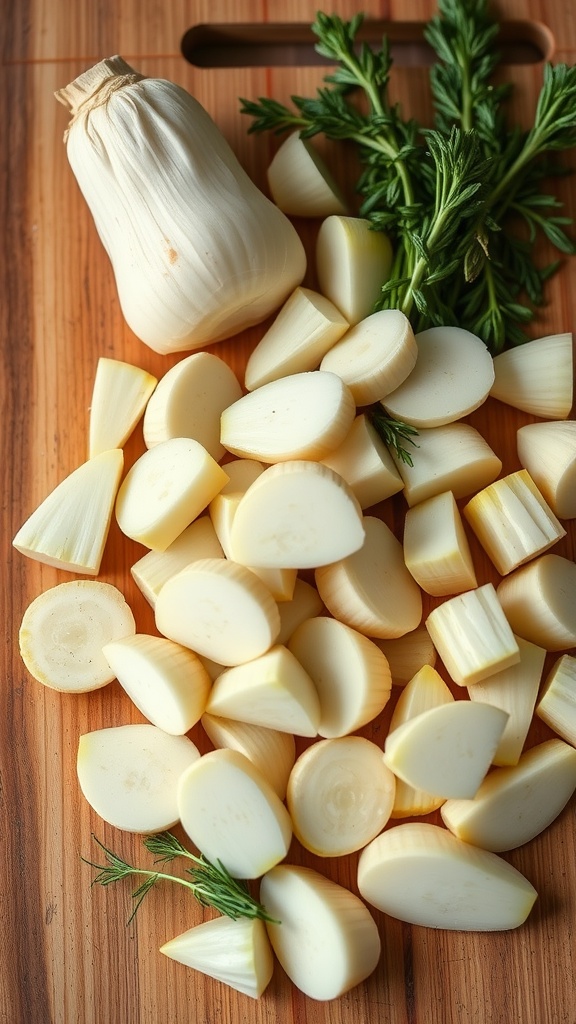
Fennel is a wonderful addition to any anti-inflammation diet. This aromatic vegetable not only adds flavor to dishes but also brings a host of digestive benefits. Its unique texture and slightly sweet taste make it a favorite in many recipes.
One of the standout features of fennel is its ability to soothe the digestive system. It can help reduce bloating and gas, making it a great choice for those following a low FODMAP diet. For anyone dealing with IBS or chronic inflammation, incorporating foods like fennel into meals can provide comfort and relief.
Fennel is versatile and can be enjoyed in various ways. You can slice it raw for salads or roast it to enhance its natural sweetness. If you’re looking for easy low FODMAP recipes, try fennel soup or a flavorful fennel and carrot stir-fry. These dishes are not only delicious but also fit perfectly within an inflammation diet for beginners.
Consider adding fennel to your anti-inflammation meal plan. Its anti-inflammatory properties pair well with other non-inflammatory foods, creating a balanced and healthy plate. Whether you enjoy it in a salad, soup, or as a low FODMAP snack, fennel is a fantastic choice for anyone looking to improve their digestive health.
Bell Peppers for Vitamin C
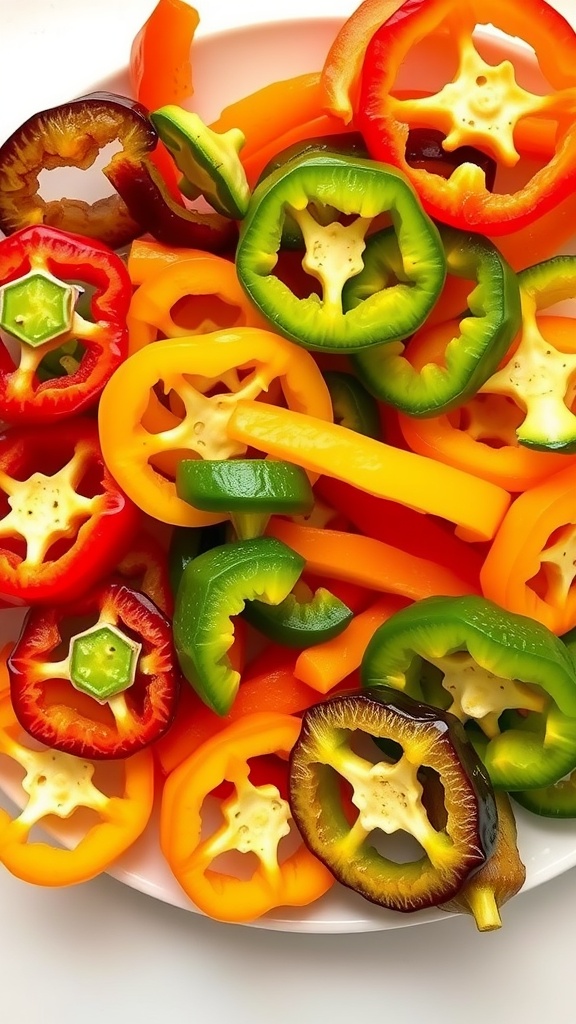
Bell peppers are a colorful addition to any meal and are packed with vitamin C. This vitamin is vital for boosting your immune system and can help reduce chronic inflammation.
The image shows a vibrant mix of bell peppers in various colors, including red, green, yellow, and even some unique shades. Each color signifies different nutrient profiles, making them a fantastic choice for anti-inflammatory meals.
Incorporating these peppers into your diet can be simple. You can snack on them raw, toss them into salads, or add them to stir-fries. They fit perfectly into low FODMAP meal plans and can serve as healthy lunch recipes or anti-inflammation snacks.
If you’re looking for easy low FODMAP recipes, consider making a bell pepper salad drizzled with olive oil and lemon. This dish not only tastes great but also helps reduce inflammation fast.
Pomegranates and Their Nutrients
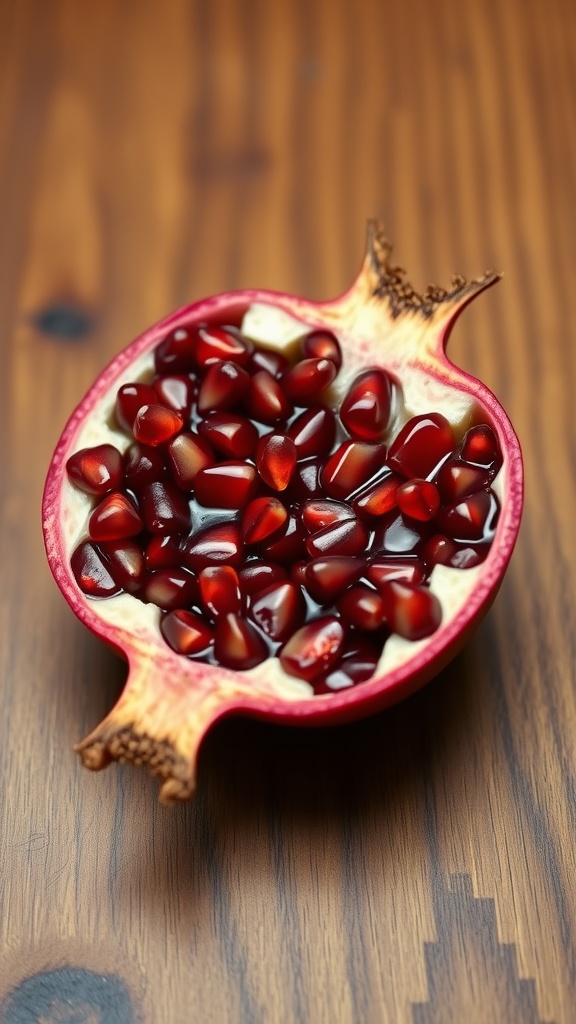
Pomegranates are not just beautiful fruits; they are packed with nutrients that can be very beneficial for those dealing with chronic inflammation. The vibrant red seeds, known as arils, are filled with antioxidants, vitamins, and minerals. These nutrients can help support an anti-inflammation diet, making pomegranates a smart choice for anyone looking to ease symptoms of fibromyalgia.
One of the standout features of pomegranates is their high levels of polyphenols. These compounds have been shown to reduce inflammation in the body. Including pomegranates in your meals can be a simple way to boost your intake of non-inflammatory foods. You can toss the seeds into salads, yogurts, or even blend them into smoothies for an added nutrient punch.
Looking for easy low FODMAP recipes? Try pomegranate as a delightful topping for your favorite IBS-friendly food. They pair well with many low FODMAP vegetables and can make your healthy lunch recipes shine. Plus, their sweet and tangy flavor can make anti-inflammatory snacks so much more enjoyable!
If you’re on an inflammation diet for beginners, incorporating pomegranates can be a great starting point. They fit well into various meal plans, whether it’s an anti-inflammation breakfast or an easy low FODMAP meal prep. So, grab a pomegranate and enjoy the benefits it has to offer!
Celery for Hydration
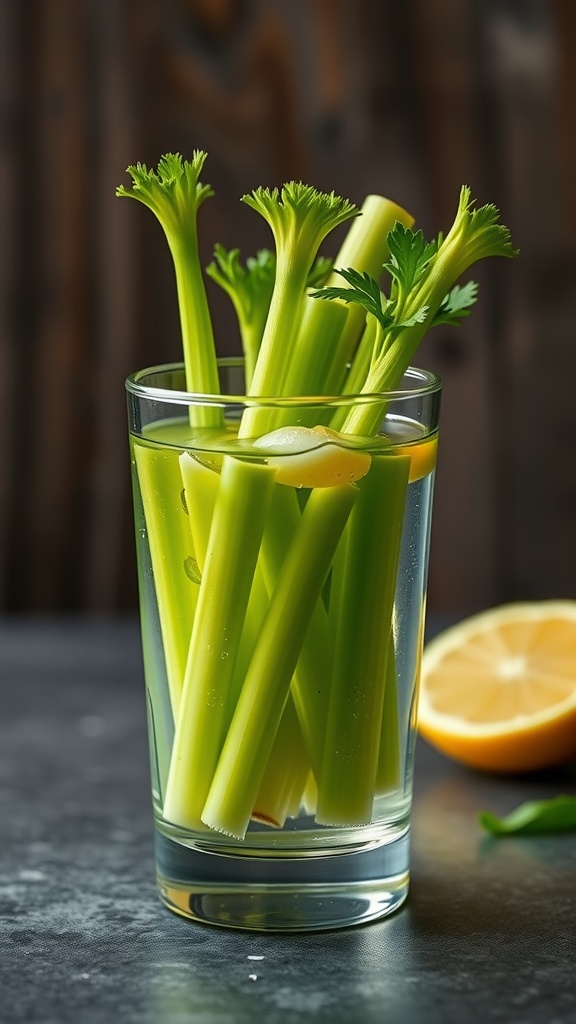
Celery is a fantastic food choice for anyone looking to stay hydrated and reduce inflammation. The image captures a glass filled with fresh celery stalks, soaking in water. This not only looks refreshing but also highlights celery’s high water content, making it a great addition to your meals.
Incorporating celery into your diet can help with hydration. It’s low in calories, making it a perfect choice for healthy lunch recipes or anti-inflammation snacks. You can even toss it into your salads or smoothies for an extra crunch.
For those following a low FODMAP diet, celery is a great option. It’s IBS-friendly and fits perfectly into your anti inflammation meal plan. You can enjoy it raw or cooked, making it versatile for various dishes.
If you’re looking for easy low FODMAP recipes, consider making a celery and lemon salad. Just chop celery, mix it with lemon juice, and add some herbs for flavor. It’s simple but delicious!
Zucchini’s Nutritional Benefits
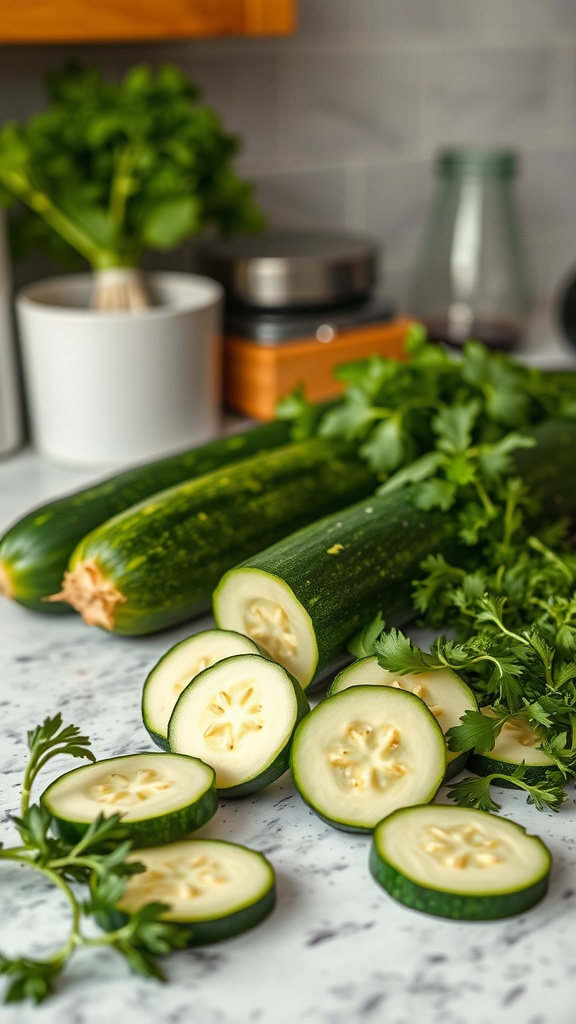
Zucchini is a fantastic addition to an inflammation diet for beginners. This low-calorie vegetable is packed with nutrients that can help reduce chronic inflammation. Its high water content keeps you hydrated, which is important for overall health.
One cup of sliced zucchini offers vitamins A and C, both of which are known for their antioxidant properties. These vitamins help combat oxidative stress, a key contributor to inflammation. Zucchini is also a source of magnesium, which supports muscle function and can ease discomfort.
This veggie is versatile in the kitchen, fitting perfectly into low FODMAP meals. You can whip up easy low FODMAP recipes like zucchini noodles or add it to salads for a crunchy texture. For a quick anti inflammation snack, try slicing zucchini and enjoying it with hummus.
Incorporating zucchini into your meals can also inspire healthy lunch recipes. Think of a zucchini and quinoa salad, mixed with herbs like parsley, which you can see in the image. This combination not only tastes great but is also filled with non inflammatory foods.
Honey’s Natural Sweetener Qualities

Honey shines as a natural sweetener that is not just tasty, but also packed with benefits. The image captures a jar of honey surrounded by vibrant flowers, adding a touch of nature’s beauty to this wholesome treat.
This golden liquid is more than just a sugar substitute. It’s considered one of the foods for inflammation, making it a great addition to an anti-inflammatory diet. Honey has been known to reduce chronic inflammation and provide soothing relief, which can be especially helpful for those dealing with fibromyalgia.
Incorporating honey into your meals is easy. You can drizzle it on oatmeal for a delicious anti inflammation breakfast, mix it into tea, or use it as a sweetener in low fodmap recipes for breakfast or lunch. Try pairing honey with non-inflammatory foods like yogurt for a light and healthy snack or an easy low fodmap recipe.
When looking at honey, consider its versatility. Whether you use it in anti inflammation recipes meals or as a topping for anti inflammation snacks, this natural sweetener can enhance flavors while contributing to your health. So, sprinkle some honey on your low fodmap meal prep or enjoy it straight from the jar for a sweet burst of benefits!
Turkey as Lean Protein

Turkey is a fantastic option for anyone looking to follow an anti-inflammation diet. It’s lean, nutritious, and a source of high-quality protein. In the image, you can see beautifully sliced turkey laid out on a platter, making it an inviting choice for meals or gatherings.
Including turkey in your meals can help you create antiinflammatory meals that support overall health. It’s low in fat compared to other meats, which aligns well with clean eating principles. Plus, with its versatility, you can easily incorporate it into your anti inflammation meal plan.
If you’re exploring low FODMAP options, turkey is a great fit too. You can enjoy it in various forms, from easy low FODMAP recipes for breakfast to satisfying low FODMAP lunch ideas. Pair it with low FODMAP vegetables for a nutritious dish.
For those dealing with chronic inflammation or IBS, turkey can fit seamlessly into your diet. It’s one of those non-inflammatory foods that can work well for your body. Serve it with fresh tomatoes, as shown in the image, for a vibrant, healthy plate.
Beef for Protein Source
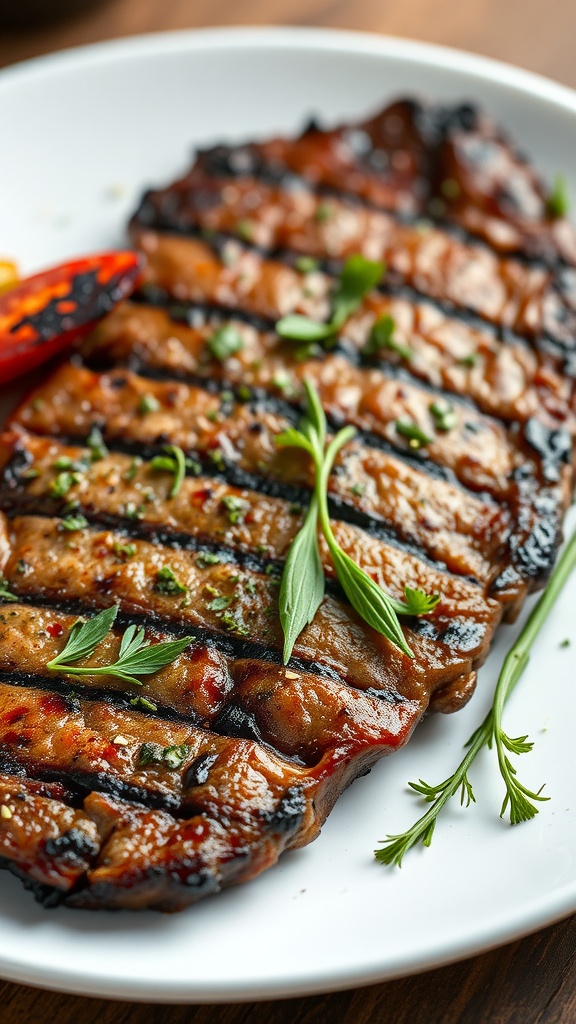
Beef can be a valuable protein source for those looking to manage fibromyalgia symptoms. The image shows a beautifully grilled steak, rich in flavor and nutrients. It’s garnished with fresh herbs, adding a pop of color and freshness to the dish.
Protein is essential for muscle repair and energy, especially for those experiencing chronic pain and fatigue. Choosing lean cuts of beef can fit into an anti-inflammatory meal plan, as they provide necessary amino acids while minimizing unhealthy fat intake.
Incorporating beef into your meals can be simple. Try it in healthy lunch recipes like beef stir-fries or salads. For those on a low FODMAP diet, using beef with suitable vegetables can create delicious, IBS-friendly meals. Opt for marinated options or grilled steaks, which can enhance flavor without adding excessive ingredients.
Check out easy low FODMAP recipes that include beef for a satisfying dinner. Beef tacos, when made with compliant toppings, can be a fun way to enjoy protein while keeping inflammation in check. Remember, the goal is to find meals that help you feel good while enjoying what you eat!
Eggs and Their Nutritional Value

Eggs are a wonderful addition to any anti-inflammation meal plan. They are packed with protein and essential vitamins, making them both nutritious and filling. This image shows a bowl filled with a variety of eggs, showcasing their lovely colors. From white to brown, these eggs are not only pretty but also versatile.
Including eggs in your diet can support your journey towards clean eating. They can be prepared in various ways, which is great for keeping meals interesting. Whether you enjoy scrambled eggs for an anti inflammation breakfast or boiled eggs as a quick snack, they fit perfectly into low fodmap recipes breakfast.
For those following the low fodmap diet, eggs are considered IBS-friendly food. They are low in FODMAPs and can help reduce inflammation fast. You can easily incorporate eggs into your low fodmap meal prep or use them in antiinflammatory meals. Think about making an easy low fodmap recipe like a vegetable omelet packed with your favorite low fodmap vegetables.
Try adding eggs to salads, sandwiches, or as part of your low fodmap lunch ideas. They also make great anti inflammation snacks when boiled. Plus, there’s nothing quite like knowing that you’re eating foods that help with inflammation while enjoying delicious meals.
Sunflower Seeds for Snacking
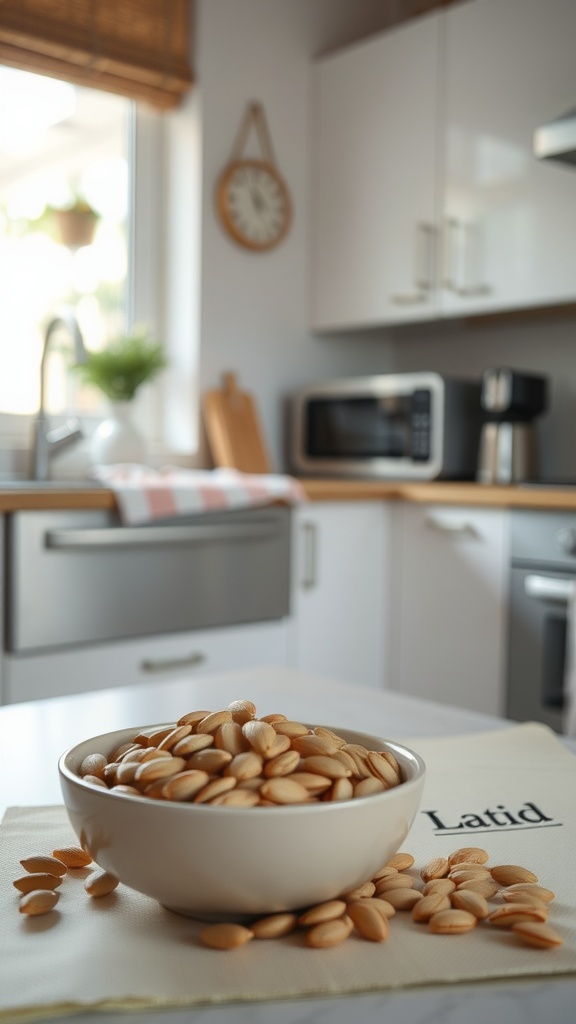
Sunflower seeds make for a perfect snack when you’re looking to fight inflammation. These tiny seeds pack a big nutritional punch, offering healthy fats, protein, and essential vitamins. They are often included in an anti-inflammatory food list, making them a great choice if you’re following an inflammation diet for beginners.
In the kitchen, sunflower seeds fit seamlessly into various meals. You can easily incorporate them into salads, yogurts, or even smoothies for an extra crunch. If you’re looking for anti inflammation snacks, consider sprinkling them over your favorite dishes. They’re not just nutritious; they also add a delightful texture.
For a quick low FODMAP snack, try toasting sunflower seeds lightly with some sea salt. This simple preparation keeps them crunchy and delicious. Plus, they are IBS friendly food, making them suitable for many dietary restrictions. Whether you enjoy them on their own or as part of a recipe, sunflower seeds are a delightful way to reduce inflammation fast.
So, next time you’re in the kitchen, keep sunflower seeds handy. They’re a clean eating staple that can enhance your anti inflammation meal plan. Try adding them to your low FODMAP meal prep for a healthy boost!
Flaxseeds for Omega-3s
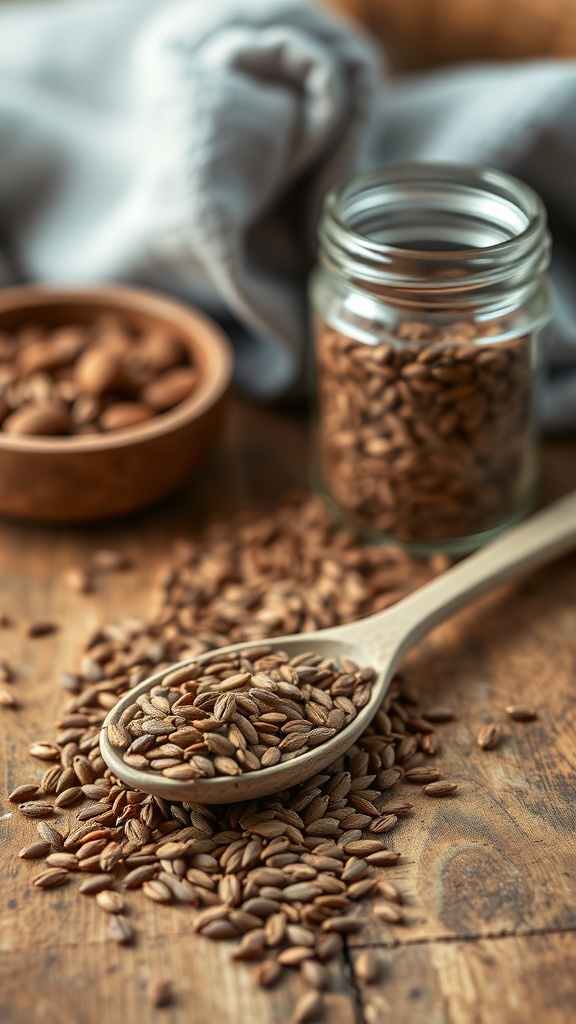
Flaxseeds are a fantastic addition to any anti-inflammation diet. These tiny seeds pack a powerful punch when it comes to omega-3 fatty acids, which can help reduce chronic inflammation in the body. The image shows flaxseeds scattered around a wooden table, with some in a small bowl and others in a glass jar. This simple yet appealing setup highlights how easy it is to incorporate flaxseeds into your meals.
You can sprinkle them on low FODMAP vegetables or mix them into healthy lunch recipes. They’re also great for making easy low FODMAP recipes, like smoothies or oatmeal. Flaxseeds are versatile and can be included in various anti-inflammation meals. For those following a low FODMAP diet, flaxseeds can be a perfect addition to your IBS-friendly food options.
Green Peas for Fiber
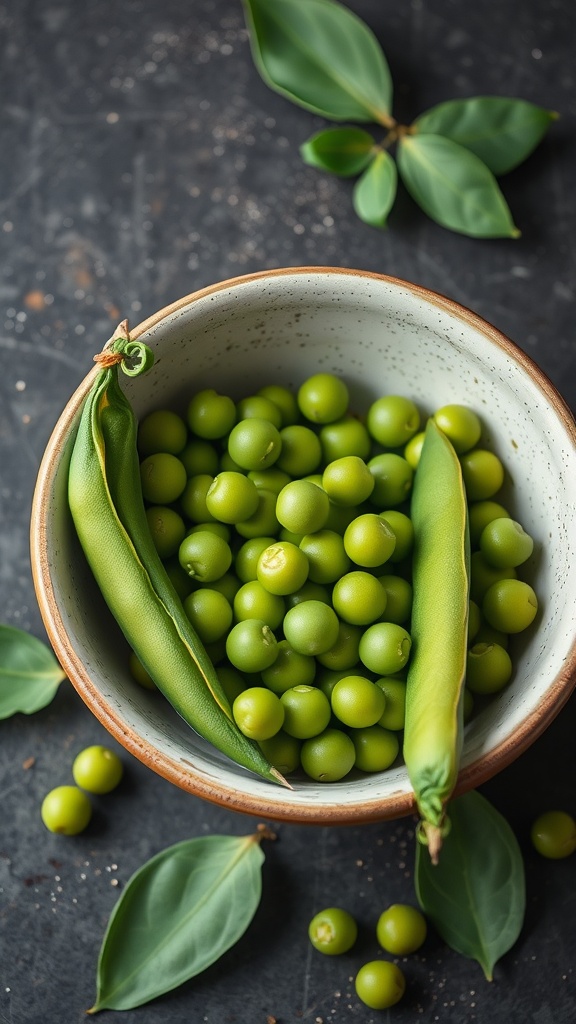
Green peas are a fantastic addition to an anti-inflammation diet. Packed with fiber, they help support digestive health, making them friendly for those on a low FODMAP diet. This colorful legume not only adds a sweet flavor to meals but also boosts nutrient intake.
Fiber plays a vital role in managing chronic inflammation. Incorporating green peas into your meals can lead to a healthier gut and overall wellness. Try them in salads, soups, or as a side dish for a nutritious boost.
For a simple dish, you can make a quick pea salad. Just toss together cooked green peas, diced cucumbers, and a squeeze of lemon juice. This refreshing salad serves as a great example of an easy low FODMAP recipe. You can also add them to your anti-inflammation meal plan by mixing peas into risottos or stir-fries.
Looking for a snack? Green peas can be blended into a tasty dip or enjoyed roasted for a crunchy treat. They’re not only delicious but also make for a healthy snack that fits right into your anti inflammation snack list.
So, grab some green peas and start incorporating them into your healthy lunch recipes. They’re versatile and can be used in many anti inflammation recipes meals, helping you reduce inflammation fast.
Raspberries for Antioxidants
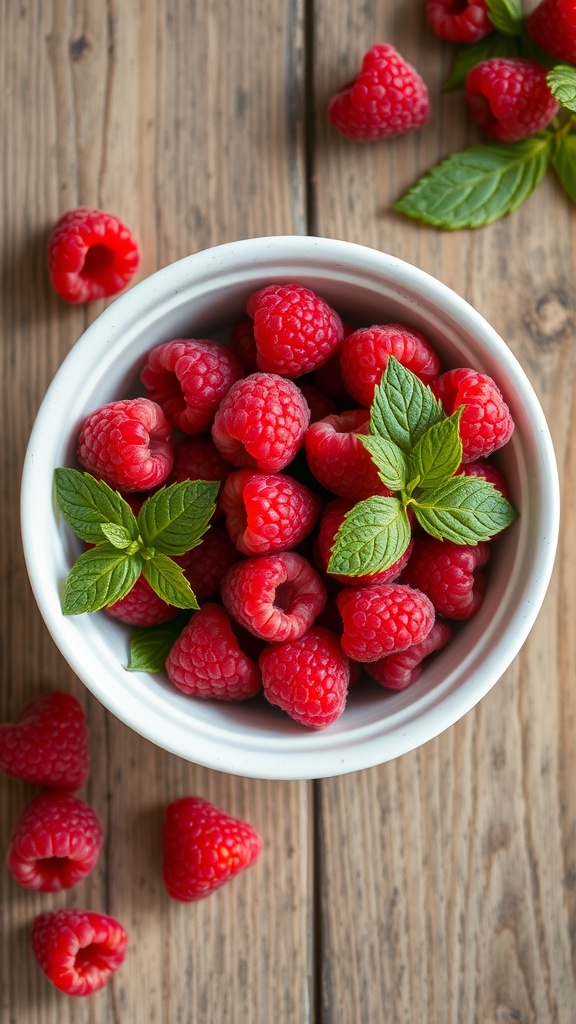
Raspberries are a powerhouse of antioxidants, making them a fantastic addition to your anti-inflammation diet. This vibrant fruit is rich in vitamin C and various phytochemicals that help combat oxidative stress. Just look at those bright red berries! They’re not only beautiful but also packed with benefits.
For those following a low FODMAP diet, raspberries fit right in. They are considered low FODMAP friendly, allowing you to enjoy them without worrying about gut issues. Toss them into your morning oatmeal or blend them into a smoothie for a delicious and healthy breakfast. You can even make easy low FODMAP recipes like raspberry chia pudding for a nutritious snack.
Want to reduce inflammation fast? Incorporate raspberries into your meals. You can add them to salads, yogurt, or even make anti-inflammatory meals like a raspberry vinaigrette. Plus, they make for a great anti inflammation snack, either on their own or mixed with other low FODMAP vegetables. Raspberries are versatile and can brighten up any meal.
So, whether you’re on an inflammation diet for beginners or just looking for healthy lunch recipes, don’t forget to include raspberries. They can play a key role in your anti inflammation meal plan while providing a tasty and satisfying option for your palate.
Cabbage for Nutritional Benefits
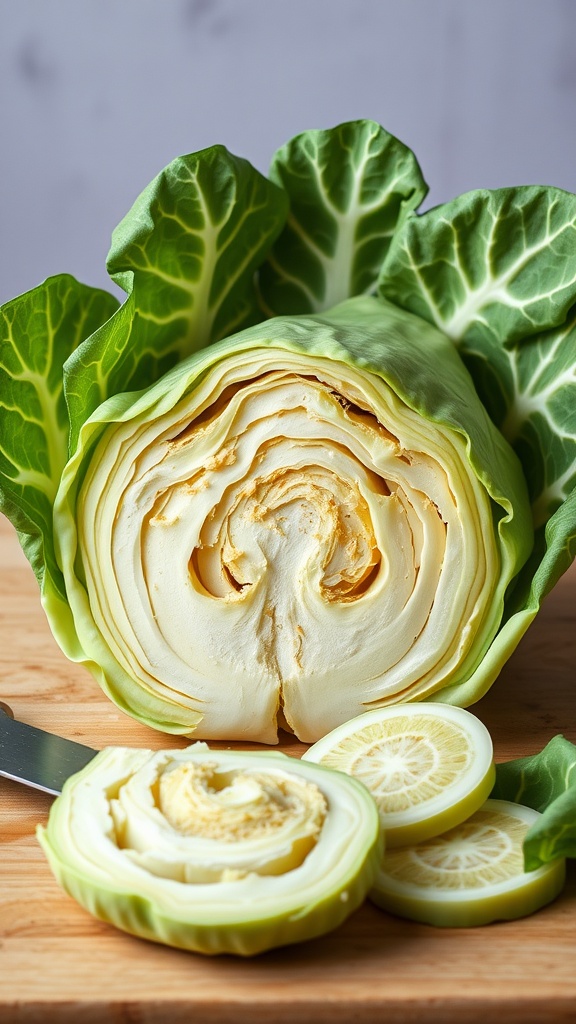
Cabbage is a powerhouse of nutrition, making it a great choice for those looking to manage fibromyalgia symptoms. This leafy green vegetable is packed with vitamins C and K, both essential for overall health.
The image shows a fresh head of cabbage with its vibrant green leaves, emphasizing its natural appeal. Slices of lemon are nearby, hinting at how well they pair together in meals. Lemon adds a zesty flavor while enhancing the cabbage’s health benefits.
Incorporating cabbage into your diet can be simple and tasty. Think about anti-inflammation recipes meals that feature cabbage as a star ingredient. You can prepare a refreshing cabbage salad or add it to soups for a nutritious boost.
For those following a low FODMAP diet, cabbage can fit into your meal plan. It’s a great option for IBS-friendly food choices. Try making easy low FODMAP recipes that include cabbage for lunch or dinner.
Overall, cabbage is one of those non-inflammatory foods that can help reduce inflammation fast. By adding it to your anti inflammation meal plan, you can enjoy delicious meals while supporting your health.
Lentils for Plant-Based Protein
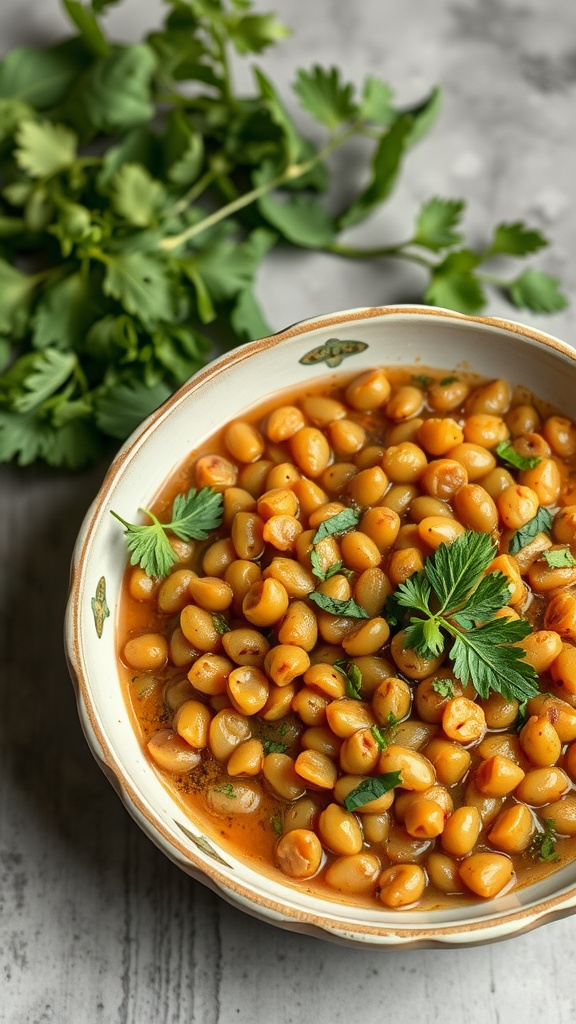
Lentils are a fantastic addition to an anti-inflammation diet. They are packed with protein, making them a great option for those following a plant-based lifestyle. In the image, you can see a delicious bowl of lentils, rich in flavor and nutrients.
These tiny legumes are not just tasty; they help reduce inflammation in the body. They are loaded with fiber, which can support digestive health, especially for those on a low FODMAP diet. If you’re looking for easy low FODMAP recipes, lentils can be a great fit.
Incorporating lentils into your meals can be as simple as adding them to salads, soups, or stews. They are versatile and can work in many anti-inflammatory recipes. You can make a hearty lentil soup with carrots, celery, and herbs. This makes for a warm, comforting meal and fits perfectly into an anti-inflammation meal plan.
For a quick lunch, consider tossing cooked lentils with your favorite low FODMAP vegetables, a drizzle of olive oil, and some lemon juice. It’s not just healthy, but also easy to prepare and delicious!
Cilantro’s Health Benefits
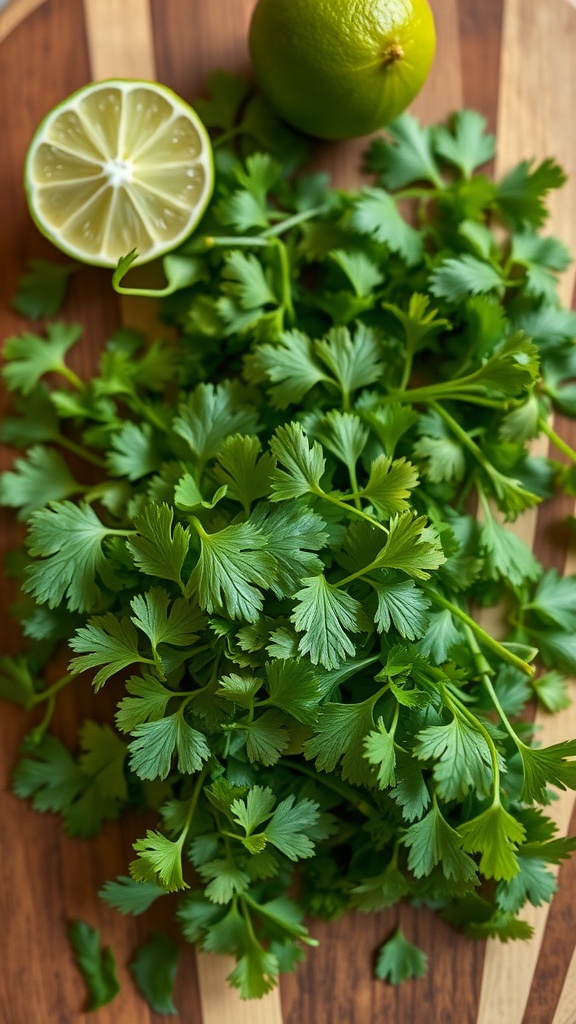
Cilantro, often seen in fresh dishes, is more than just a garnish. This vibrant herb packs several health benefits that can be especially helpful for those dealing with fibromyalgia. Its bright green leaves are not only appealing but are also loaded with essential nutrients.
This herb contains antioxidants which can help combat chronic inflammation. For those on an inflammation diet for beginners, adding cilantro can be a great choice. It’s part of a clean eating approach and is versatile enough to fit into various low FODMAP recipes for breakfast, lunch, or dinner.
Cilantro pairs beautifully with foods that help with inflammation. You can toss it into salads, blend it into smoothies, or sprinkle it on grilled meats for added flavor. If you’re looking for anti inflammation snacks, consider making a fresh cilantro salsa. It’s simple: chop cilantro, mix it with diced tomatoes, lime juice, and a pinch of salt for a refreshing treat.
For meal prep, you can include cilantro in your low FODMAP meal plan. It goes well with many low FODMAP vegetables, making it easy to incorporate into your dishes. Whether you’re whipping up antiinflammatory meals or searching for easy low FODMAP recipes, cilantro should definitely be included!
Sardines for Omega-3 Oils
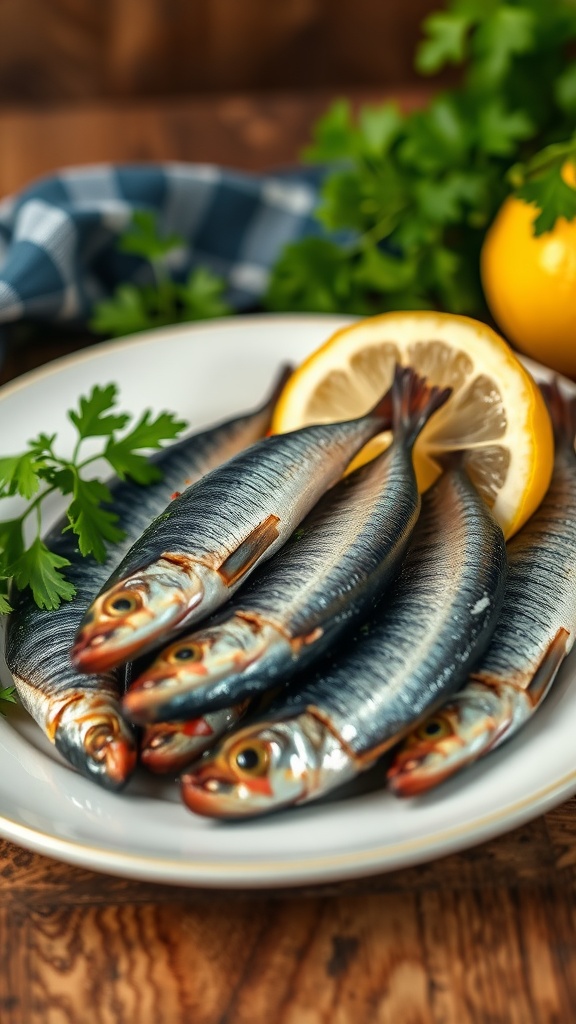
Sardines are a fantastic choice when it comes to adding omega-3 oils to your diet. These little fish pack a big punch in terms of nutrition, helping to reduce inflammation fast. They’re not just tasty but also loaded with health benefits.
Including sardines in your meals can support an anti inflammation diet. Their high omega-3 content helps combat chronic inflammation, making them an ideal option for anyone looking to improve their overall health. Plus, sardines are low fodmap, making them suitable for those following a low fodmap diet.
If you’re looking for easy low fodmap recipes, try grilling sardines and serving them with a squeeze of lemon. You can even add them to salads or pasta dishes for a healthy lunch or dinner. Sardines also work great in anti inflammation snacks like spreads or dips.
For those interested in clean eating, sardines fit perfectly into your meal plan. They’re non inflammatory foods that you can enjoy regularly. Try incorporating them into your anti inflammation meal plan for a simple and nutritious option that’s also IBS friendly.
Mint for Digestive Comfort
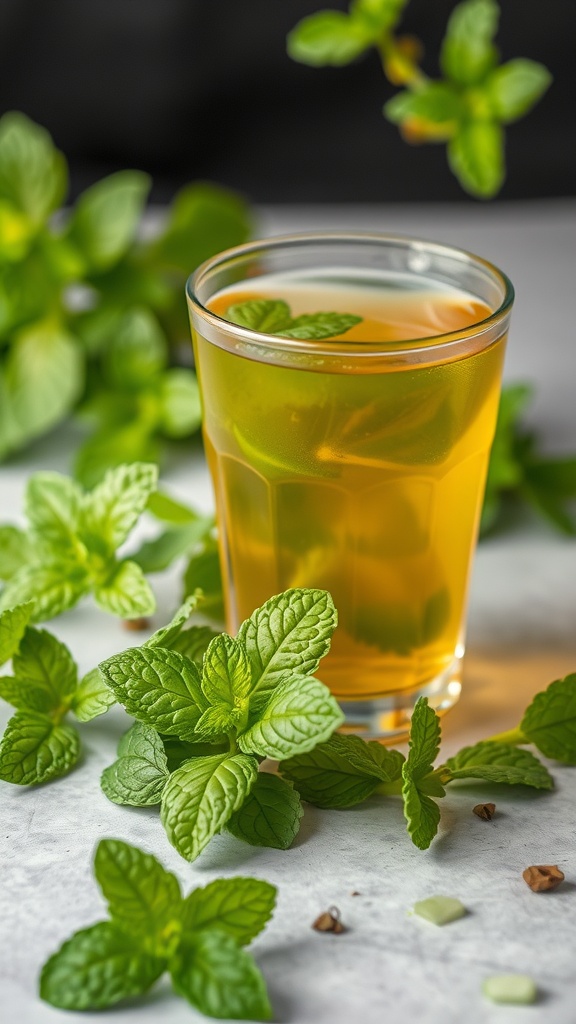
Mint is more than just a refreshing herb; it’s a natural remedy that can help with digestive comfort. This vibrant plant often appears in teas and dishes, making it a delightful addition to your meals.
In the image, we see a glass of mint tea, surrounded by fresh mint leaves. This drink not only tastes great but also offers numerous benefits for those looking to reduce inflammation. Mint can help soothe an upset stomach and relieve symptoms of IBS, fitting nicely into a low FODMAP diet.
Incorporating mint into your daily routine can be simple. Try making a quick mint tea by steeping fresh leaves in hot water. This easy low FODMAP recipe can be a go-to drink when you’re feeling bloated or just need some digestive relief.
Whether enjoyed as a refreshing drink or used in cooking, mint can be part of your anti-inflammation meal plan. Consider adding it to salads or smoothies for a flavor boost that also supports your inflammation diet for beginners.
Broccoli Sprouts for Nutritional Boost
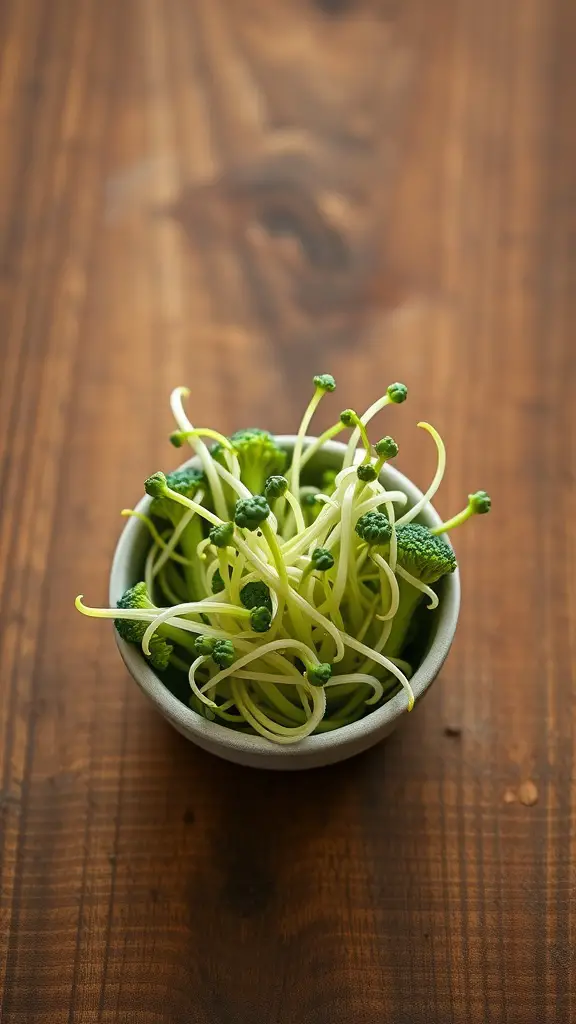
Broccoli sprouts are tiny powerhouses packed with nutrients. These sprouts are young broccoli plants that are just beginning to grow. They are typically light green with delicate stems and small florets, making them visually appealing and nutritious.
Adding broccoli sprouts to your meals can significantly enhance your anti inflammation meal plan. They are rich in sulforaphane, a compound known for its anti-inflammatory properties. This makes them one of the top foods for inflammation and an excellent choice for anyone looking to manage chronic inflammation.
Incorporating these sprouts into your diet is simple. You can toss them into salads, add them to sandwiches, or blend them into smoothies for a nutritional boost. They are also suitable for IBS-friendly food options, as they are considered low FODMAP, making them a great addition to your low FODMAP meal prep.
For a quick and healthy lunch, try making a wrap with whole grain tortilla, grilled chicken, and a handful of broccoli sprouts. This easy low FODMAP recipe is not only delicious but also offers great anti inflammatory benefits. Remember, foods that help with inflammation can be tasty!
Best Anti-Inflammation Foods for Fibromyalgia
When my wife and I began investigating natural methods to soothe her fibromyalgia symptoms, it became evident that food played a dual role—it was either exacerbating her discomfort or aiding in her battle against it. Our extensive research made it clear that certain anti-inflammation fibromyalgia foods have the capability to alleviate chronic inflammation, stabilize hormonal activity, and even minimize flare-ups.
Transitioning to an anti-inflammatory diet was initially daunting. Eliminating processed foods, refined sugars, and dairy products was overwhelming. But as we shifted our focus to what she could incorporate into her diet rather than what she had to exclude, our approach became much more feasible. We unearthed a variety of delicious, healing foods that not only mitigated her fibromyalgia symptoms but also enhanced her digestion, energy levels, and overall mood.
Anti-inflammatory foods function by reducing oxidative stress and promoting gut health—two vital elements in managing fibromyalgia symptoms. Many individuals with fibromyalgia experience IBS-like symptoms, including bloating, constipation, and pain after eating. This is why integrating anti-inflammatory foods with a low FODMAP diet can be transformative for many.
How I Helped My Wife Heal with Anti-Inflammation Foods
I’ll never forget the moment my wife broke down in tears, overwhelmed by her relentless struggle with fibromyalgia. The chronic pain, the fatigue, and the sleepless nights—it had all become unbearable. We felt helpless, caught in a vicious cycle of symptoms and disappointment. Doctors prescribed painkillers and recommended lifestyle changes, but these brought only temporary relief. That’s when we decided to dig deeper, seeking solutions beyond conventional medicine.
This exploration led us to anti-inflammation foods. It wasn’t a quick fix, but as we gradually transformed her diet, we noticed incremental improvements. Her energy levels began to even out. The pervasive fatigue that clouded her days started to lift. Her mental fog cleared, and for the first time in a long time, she felt a sense of control over her symptoms.
Initially, the dietary changes were daunting. Eliminating processed foods, sugars, and other inflammatory agents felt like yet another set of restrictions in a life already full of challenges. But we shifted our perspective. Instead of dwelling on what she couldn’t eat, we focused on the nutritious, healing foods she could enjoy.
We embraced anti-inflammatory meal plans, introducing foods that supported her body rather than exacerbated her symptoms. Omega-3-rich fish, like salmon, became a regular part of our meals. We snacked on blueberries and walnuts instead of processed sweets. We incorporated anti-inflammatory spices like turmeric and ginger into our cooking, and gradually, her symptoms became more manageable.
I won’t claim it cured her—because fibromyalgia has no cure. But I will say this: it brought us hope. Watching my wife transition from feeling imprisoned by her body to reclaiming her vitality was profoundly moving. If you or your loved one is battling fibromyalgia, I want you to know that you’re not alone, and there is a path forward.
Final Word on Anti-Inflammation Foods for Fibromyalgia
As we’ve explored in this post, incorporating anti-inflammation foods into your diet can significantly impact managing fibromyalgia symptoms. While no diet can cure fibromyalgia, making informed choices about what you eat can help mitigate the intensity of symptoms like pain, fatigue, and cognitive fog. The journey to discover what works best for your body can be challenging, but it’s also an empowering process of trial and discovery.
The key takeaway is that a diet rich in anti-inflammatory foods can offer more than just symptom relief; it can improve overall quality of life. By reducing inflammatory responses in the body, these foods help to decrease overall discomfort, enhance energy levels, and promote a healthier mental state. Whether it’s incorporating more omega-3 fatty acids, antioxidants, or fiber-rich foods, each small change can make a significant difference.
Remember, it’s important to approach changes to your diet with a balanced perspective and, ideally, with the guidance of a healthcare professional. Not every food will suit every individual, and what works for one person may not work for another. Listening to your body and adjusting your dietary choices to suit your unique needs is crucial.
We encourage you to experiment with the anti-inflammation foods listed in this post and observe how your body responds. With patience and persistence, you can find a dietary rhythm that not only manages your fibromyalgia but also enhances your overall wellbeing.


About Me
Hi, I’m Lucjan! The reason why I decided to create this blog was my beautiful wife, who experienced a lot of pain in life, but also the lack of information about endometriosis and fibromyalgia for men…
